Expectation:
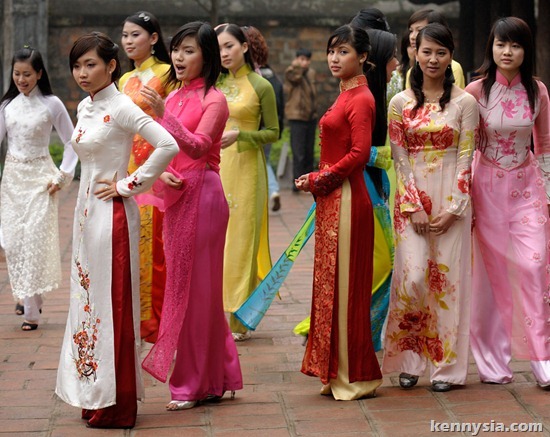
Reality:

"Thank you for ordering from VietnameseMailOrderBride.com"
"Sorry, the picture you seen in the catalogue was for illustration purposes only."
Expectation:

Reality:

"Thank you for ordering from VietnameseMailOrderBride.com"
"Sorry, the picture you seen in the catalogue was for illustration purposes only."
When I was in Vietnam, I followed some of the local volunteers to have "The Best Snails in Hue City".

Yes, SNAILS.
Slimy, squirmy, fat, juicy little snails, fresh from the garden, complete with their shells!

This is the restaurant cafe somebody’s house carpark where we’ll be devouring our shelly little friends.

Ignore the bruise mark on my forehead. When people ask me why, I tell them truth: I went to have a bowl of pho, I complained of a headache, and the pho lady suddenly appear to pinch my head to "get rid of the wind".
When she’s done. I have no more "wind" in my head. Instead I have a red mark on my face.
You can’t get an experience any more Vietnamese than that.

Wearing dental gloves and plastic glass for protection because it’s gonna get messy!

First, you take a freshly-cooked snail from the pot.

Then you pick the slug out from its shell using a toothpick.
Dip it into chilli or lime sauce, then put it on your tongue.

Next, allow the slug to slowly crawl its way into your stomach.
KIDDING!
You quickly swallow the contents of the snail.
The meat of the slug is a bit tough, kinda like beef tendons or uncooked sotong. There’s not much you can chew.
Flavour-wise, it tastes a bit like EARTH-FLAVOURED clams. I guess the best way to eat them is to dip them into lots and lots of dipping sauce for the best experience.

If this is your first snail-y experience, then give the most excruciating expression on your face for entertainment.
My friends asked me how I felt after I swallowed my first snail in Vietnam.

"Sluggish," I said.
This has gotta be the biggest coconut I have ever seen!

I am in Hue, central Vietnam right now and one thing I definitely noticed here is how big the coconuts here are.
Seriously, check out the size comparison with that chair!

Yes, I believe it is almost as big as my testicles. (Except mine is bigger)
Amusingly, the bananas here are comparatively small.

In fact, they are so tiny it’s pathetic.
I realised I haven’t yet blogged about the trip to Vietnam I had last year.
You can obviously tell that the trip was from a long time ago because that pic was from when I still had hair.
Actually I had wanted to blog about this trip earlier, but as soon as I returned from Vietnam, Israel launched an attack Gaza. A lotta people were getting emotional as a result. Considering I couldn’t blog about Ho Chi Minh City without mentioning the horrors of the Vietnam War, I decided to put the entry on hold.
Until I kinda forgot about it. Hehe.
There is a reason why people described George Bush’s war in Iraq as a repeat of the Vietnam War.
Back in the 1960s, Vietnam was split into two halves, the communist north and the democratic south.
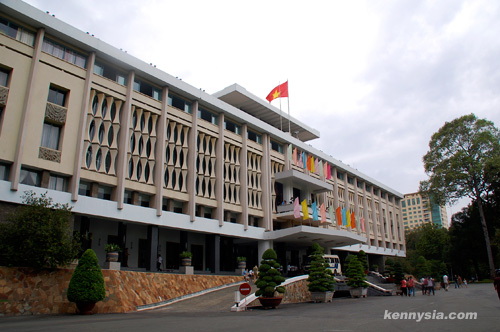
The Americans weren’t even involved in this conflict at first. But because this was during the height of the Cold War, they were desperate to “spread democracy” and rid the world of communism in order to assume world domination.
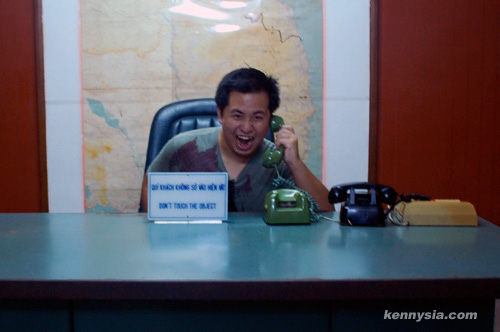
So they sent in their troops into Saigon help the South Vietnamese fight the war, thinking that it’ll be an easy victory since they have bombs, tanks and planes. All the North Vietnamese had back then were primitive sticks and stones.
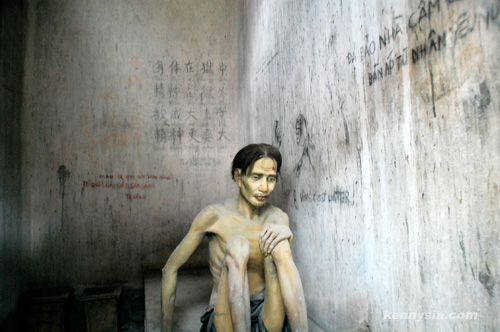
What the Americans thought was gonna be a swift one-sided war turned ugly when the they find themselves ambushed repeatedly by pro-communist soldiers and civilians alike hiding inside tunnels and Vietnam’s thick jungles. The Americans responded with more shock-and-awe, poisoning jungles with Agent Orange, wiping out villages with napalm bombs and indiscriminately killing innocent women and children.
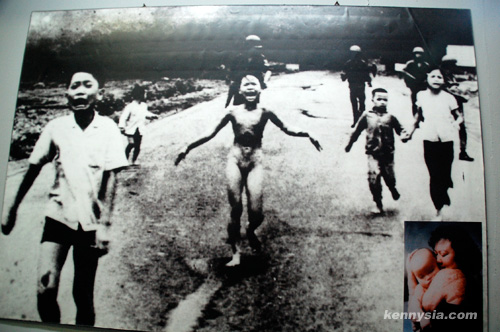
By the end of the war, half a million 50,000 American troops perished and millions more Vietnamese from both sides suffered casualties. American troops were forced to leave Vietnam due to pressure from the hippie movement, and this immediately paved way for the North Vietnamese to capture Saigon and renamed it Ho Chi Minh city.
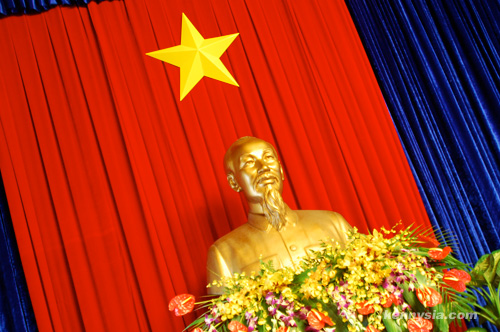
I gotta be honest here.
I didn’t enjoy Ho Chi Minh City. I loved Hanoi to bits when I went there two years ago, and I thought HCMC would be something similar. Instead, we were confronted by depressing sights everywhere we went.
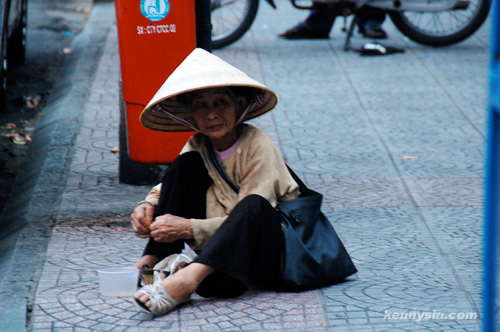
The museum we went to that showcased photos from the war in particular brought our spirits down and made us feel so depressed. It’s almost as if we paid for this holiday just to feel depressed. 🙁
Even the sight of this grown man holding onto his massive collection of colourful balloons didn’t cheer us up.
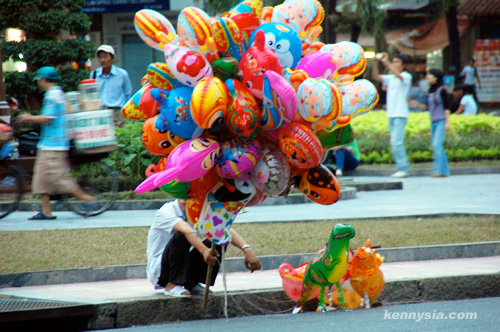
I think part of the reason why I lacked enthusiasm had to do with the fact that we got ripped off like 3 hours after we touched down from the airport.
My travel partner Nadia and I were at a market 5 minutes away from our guesthouse, and we decided to take a cyclo (Vietnamese version of a trishaw) back.
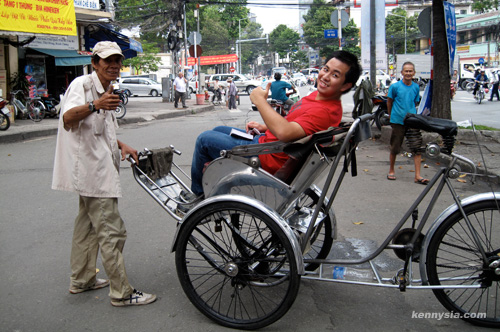
One of the riders approached us and asked 30,000 dong (RM 6) for the trip. Seems reasonable.
After they dropped us off, suddenly they asked for 300,000 dong (RM 60)! How can a freaking 5 minute journey on a bicycle cost RM60?!
For that price, I would’ve expect the cyclo to be made from Louis Vuitton or something.
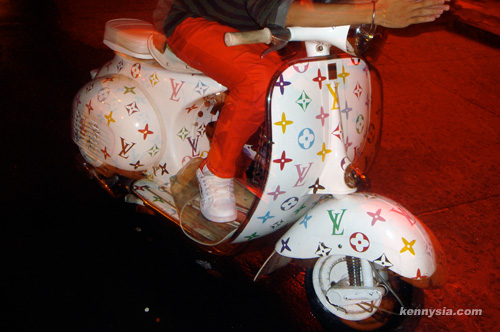
Obviously we refused to pay lah. Some more kena blamed for hearing him wrongly. In the end, I got so pissed off that I just gave them 100,000 (RM 20) and scurried away.
I wasn’t happy, but I told myself that I can’t blame them for trying to scam us.
Many of these cyclo riders were in fact educated doctors and lawyers before the Vietnam War. Because they were anti-communists, their homes and possessions were all taken away when the communist government took over. They were outcasted and not given work permit, effectively forcing them to work illegally as cyclo riders who run around overcharging tourists.
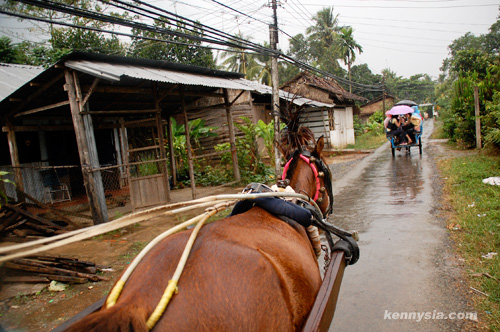
We couldn’t stand HCMC any longer, so Nadia and I booked a day trip for a visit down the Mekong River on our second day.
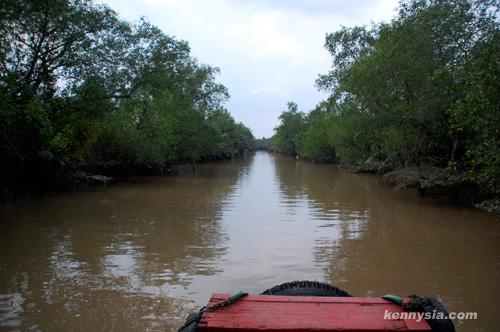
It was a pleasant getaway from the noise and chaos of the city, but we still couldn’t escape from the mechanical tourist traps they set up for us over there. We went to one village, they showed us how to make spring rolls.
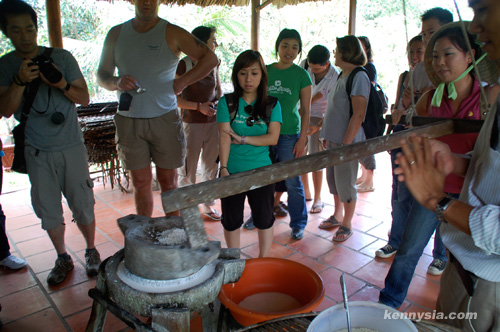
We went to the next village, they sell us coconut candy.
We went to the next village, they tried to sell us honey tea.
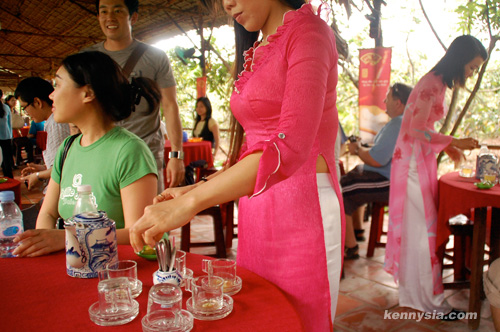
Then finally they made us all sit down to listen to our waitress sing some ridiculous Vietnamese opera songs while they asked for more tips!

By the time we return to HCMC, it was 8pm and we were pretty hungry. So Nadia and I walked over to this French restaurant recommended by my Lonely Planet guidebook.
It was the most interesting French restaurant experience I’ve ever had. And I don’t mean in a good way!
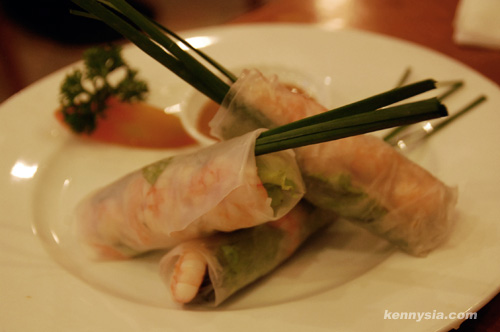
The food wasn’t bad – it was okay.
The experience was interesting because while we’re at the restaurant, the ASEAN Cup grand final between Vietnam and Thailand was going on and all the waitstaff were literally glued to the TV. That’s fine. Nadia and I can entertain ourselves with miniature Vietnamese flags while we’re being ignored.
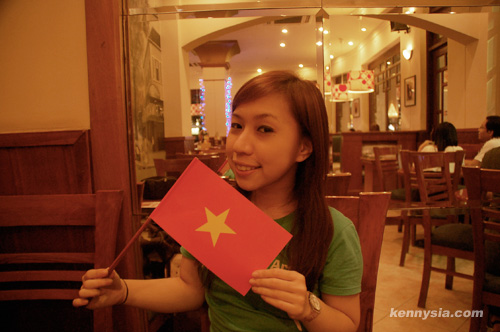
But then something unexpected happened.
During the game, Vietnam scored a late goal and became ASEAN Cup football champions for the first time in history.
Within minutes, thousands of revelers in motorbikes clad in patriotic red screamed, danced, raced through the streets to celebrate their victory.
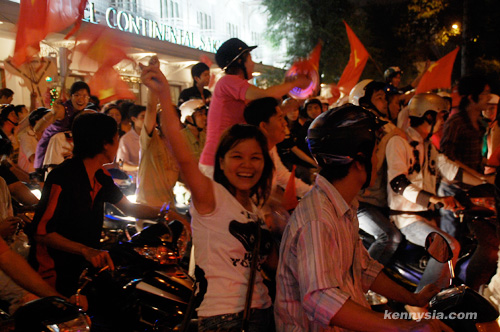
It was all fun and games at first, but the excitement quickly degenerated into something scary. We finished our dinner and wanted to go back to our guesthouse, but then it suddenly dawned on us that there’s no chance in hell that we could get a taxi in this kinda situation.
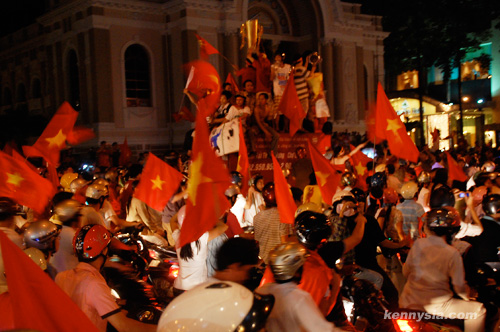
With the crowd showing no signs of subsiding, we took refuge in a nearby rooftop bar.
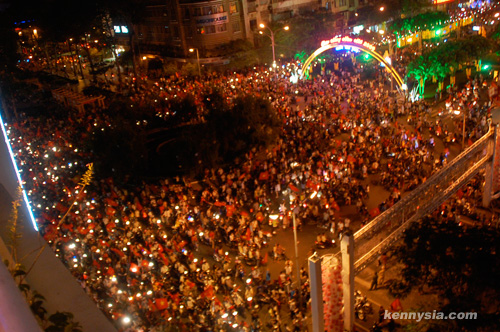
You will NEVER see Malaysians celebrating on the streets so crazily like that. Not because we are disciplined people, but because our football team is totally hopeless!
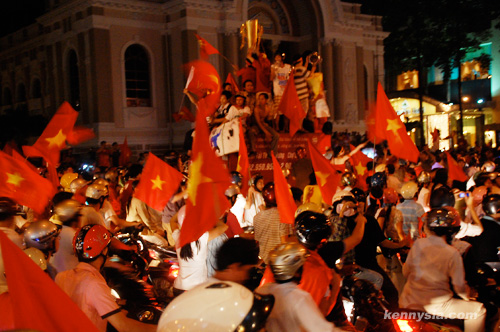
Two hours had gone by and still people were clogging up the streets!
We were tired, sweaty and smelly. Eventually we decided to put our lives at risk and walk some 40 minutes back to our guesthouse, narrowly avoiding becoming motorcycle roadkills along the way.
Till today, I wondered what a miracle it was that we even made in back in one piece.
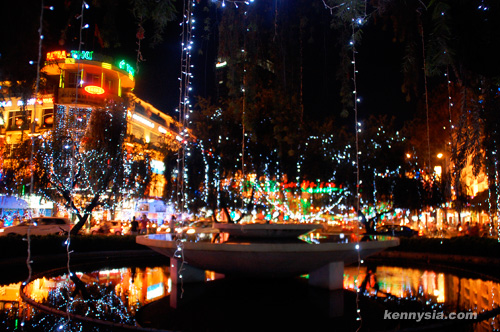
Apart from those annoyances though, I still think Ho Chi Minh City is a beautiful place. I especially enjoy admiring the architecture of their buildings.
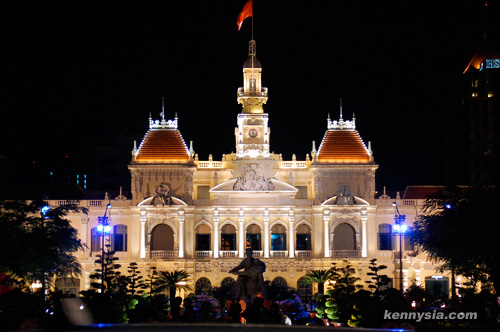
The buildings in Ho Chi Minh City are very unique for a city in South-East Asia. Decades of French colonization resulted in many of their buildings having a chic Parisian flavour to it. In fact, it’s almost as if some of their buildings were directly imported from Europe.
They got their own Notre Dame Cathedral.
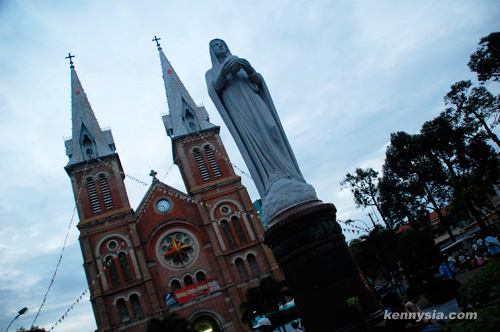
Even their own Toni&Guy hair salon.
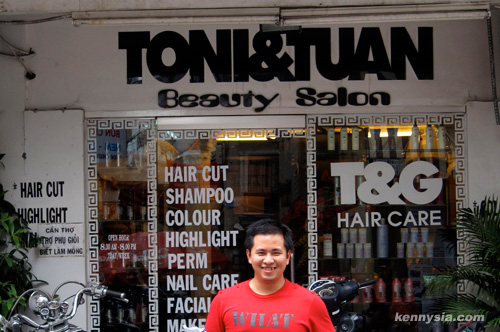
Wait a minute, that is not Toni&Guy.
I would be a Viet Cong soldier.
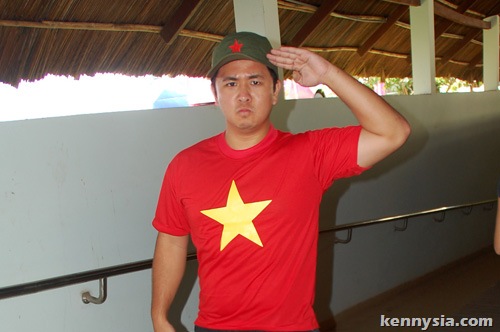
At least that was the impression I get after watching a Vietnam War propaganda video during my visit to Cu Chi, a war site located near Ho Chi Minh City in Vietnam.
The black-and-white video, filmed just after the war, nearly had me convinced that I should learn to be like that valiant 12-year-old peasant girl who fought for her country, killed 118 "devil" Americans and was declared "American Killer Hero" (their words, not mine) by her communist government.
A couple of Americans in our tour group were flinching uncomfortably after watching the video. Clearly they’d think twice when approached by a deadly 12-year-old Vietnamese girl next time.
Of course, the Vietnam War has long past, the Cold War has warmed up, the animosity between the Vietnamese and Americans have long ceased, but this war between the Americans and the communists remained one of the most fascinating in history.
How is it possible that the Americans, with their superior war planes and technology, lost out to a bunch of communist Viet Congs who probably never handled a gun before their entire lives?
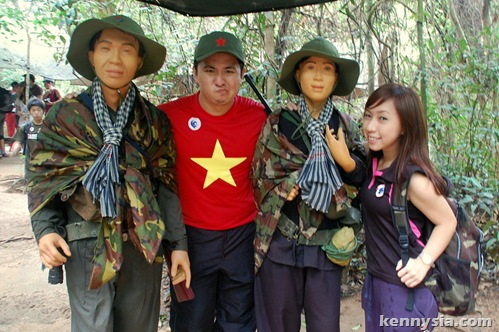
The answer lies underground in Cu Chi, a Viet Cong village 90km away from the anti-communist stronghold of Saigon.
Cu Chi is pronounced "koo chi". Yes, the Hokkien word for "tickle" is also called "koo chi".
But these stealthy underground tunnels beneath Cu Chi ain’t no laughing matter!
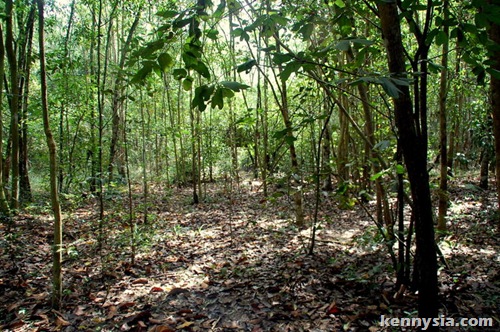
As the Americans bombed the surface with their napalm bombs and B-52s, hundreds of Viet Cong soldiers were secretly hiding underground, emerging only during night time to launch surprise attacks on their enemies.
They lived in there, sometimes up to months at a time. The tunnels were so well-equipped that there were even sleeping chambers, kitchens and hospitals for the Viet Cong soldiers.
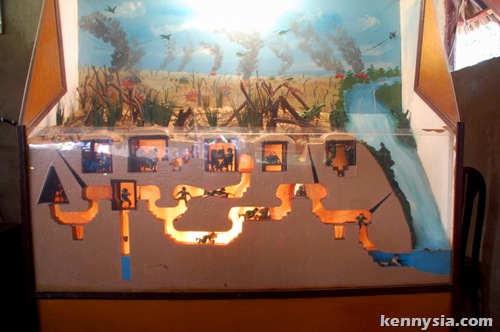
Of course, the Americans trained soldiers as their "tunnel rats" and attempted the infiltrate the tunnels.
But when they entered, they risked having their sorry faces smashed right into one of these.
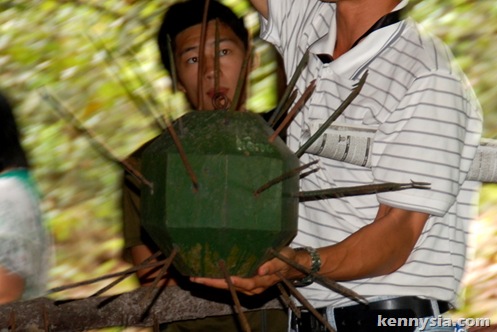
So successful were the Cu Chi Tunnels that eventually that Americans retreated.
Ho Chi Minh’s communist government took over Vietnam and ruled till today. Meanwhile, Cu Chi became a tourist site charging visitors USD6 + VND80,000 (or RM36 total) per entrance.
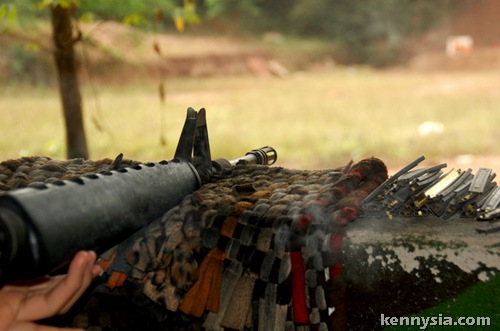
There’s a firing range at the Cu Chi Tunnels, where they let visitors try their hands on some real guns used by Viet Cong soldiers during the war. A round of ten bullets cost about USD10 (RM36).
It’s a little expensive, but these are real guns, using real bullets.
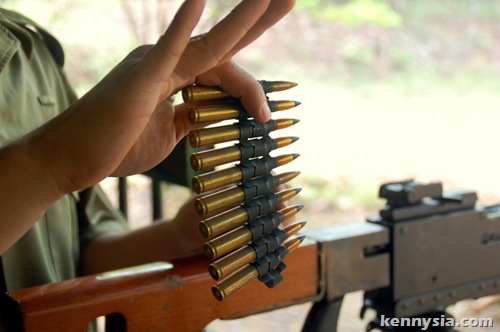
Considering this was probably the only chance I’m gonna get, I simply could not pass up on the opportunity to fulfil one of my male fantasies.
After years of playing games like Counterstrike, I finally had the chance to fire the real version of my favourite weapon, the AK47.
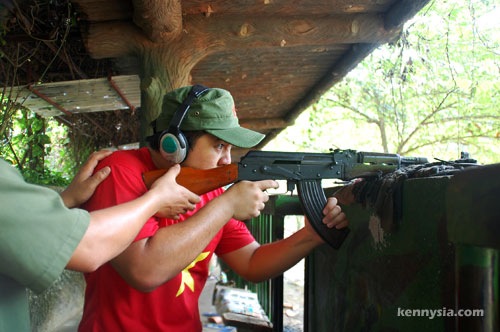
Videos games are fun, but nothing beats holding on to the real thing. I was imagining a terrorist leaping across in front of me as I pulled the trigger.
"Enemy sighted!"
BANG! BANG! BANG!
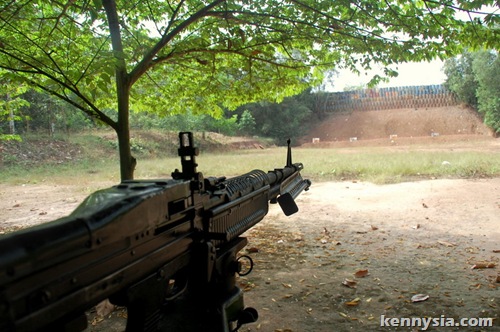
"Counter-terrorist wins!"
Such a cool and satisfying experience. It was exactly like Counterstrike.
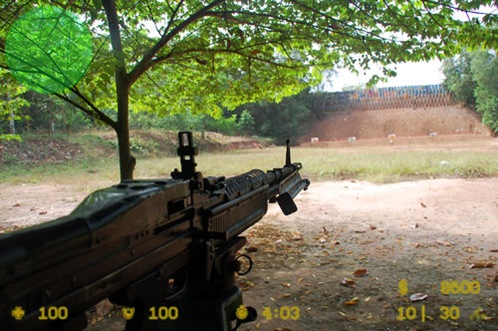
But with much better graphics.
This one is a M60 machine gun. It had a much stronger recoil and damn, it was loud! Without the ear muffs on, the deafening ringing effect in my ears could last for a few seconds after each shot.
Imagine how the Viet Congs have to endure all these back in the days. No one wonder so many of them went crazy.
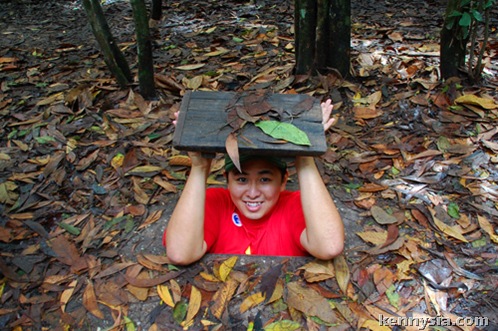
After having our fun at the firing range, we had the chance to explore a section of the underground tunnel.
Getting into the hole was no problem for me – the tunnel had already been enlarged to accommodate much bigger (read: fatter) Western tourists.
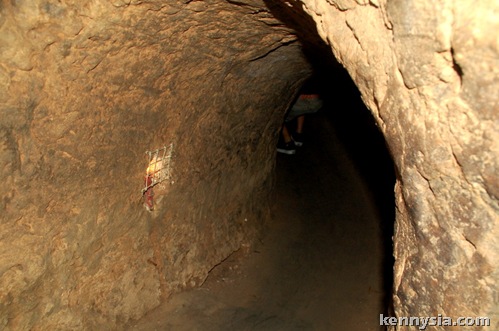
But crawling through the tunnel… now that’s definitely an experience.
The tunnel, even after enlarging was still extremely small. We spent 10 minutes wriggling and manoeuvring through a 100m section and already we’re sweating like pigs.
I shudder to think how it was even possible that the anyone could tolerate living underground during war time.
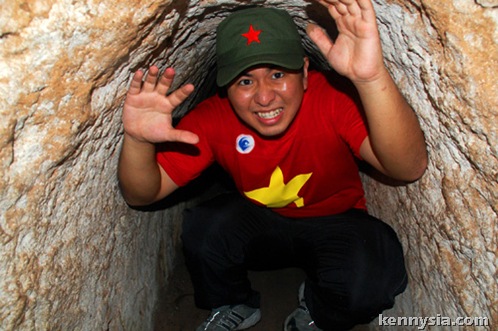
The Viet Congs were living under absolute extreme conditions.
There may be a kitchen and a well, but there were definitely no shower or toilets in the tunnels. To top it off, air ventilation underground was dismal at best. The stench of 800 sweaty men must have been unbearable.
Next to deadly enemy fire, the main c
oncern for Viet Congs must’ve have been deadly body odour. Times like these, they gotta wish they had…
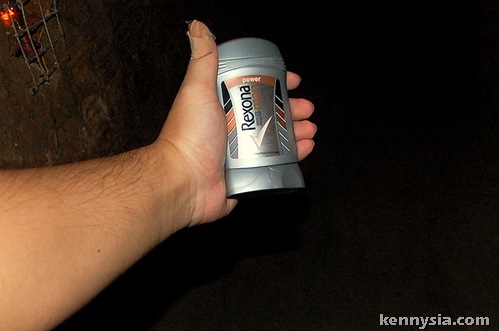
Rexona Men Absolute Protection deodorant.
The latest most powerful deodorant from Rexona Men ever!
I mean, just check out its product description on the back.
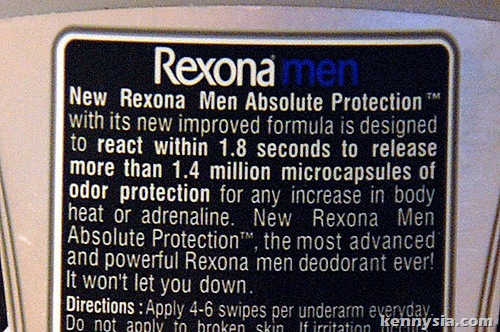
"New Rexona Men Absolute Protection with its new improved formula is designed to react within 1.8 seconds to release more than 1.4 million microcapsules of odor protection for any increase in body heat or adrenaline. Rexona Men Absolute Protection, the most advanced and powerful Rexona men deodorant ever! It won’t let you down."
Wow. Sounds extremely extreme.
I think they must have left out the part where it says it will MAKE YOU FLY THROUGH THE AIR AND SHOOT MISSLES OUT FROM YOUR NOSE.

No doubt, the deodorant smells pretty good.
Some say they love the smell of napalm in the morning.
But surely, "napalm in the morning" cannot possibly smell better than my fresh and dry armpits.
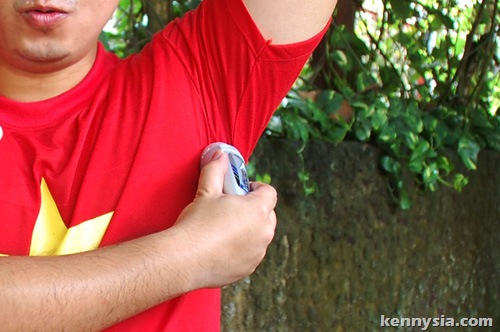
This, smells like… victory!
P/S. Join the Rexona Absolute Extreme blog contest. There aren’t many entries received yet, so the chances of winning are very high.
Finally, I’m writing the last piece of my Hanoi travelogue.
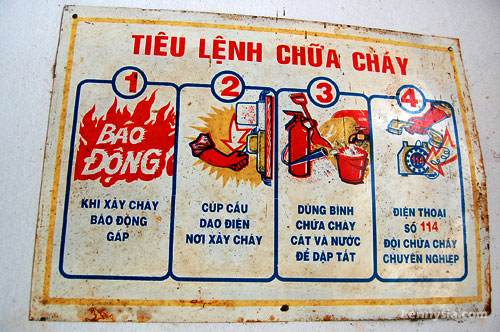
You had me at ‘Bao Dong’
Kinda strange I made a 4-day trip seems like 4 months on my blog.
*~*~*~*~*~*~*~*~*~*
On the first day of our visit, we thought about hiring a bicycle (US$1.50 / RM5) to help us get around.
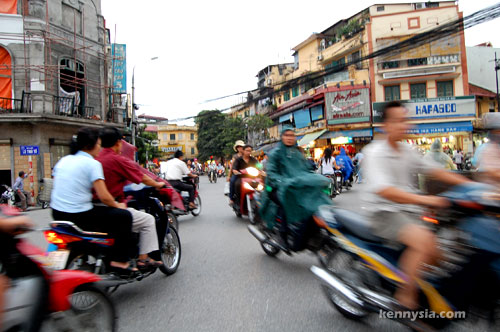
Looking at how crazy the way people drive in Hanoi, I didn’t think it was a good idea. But we went ahead with it anyway.
*~*~*~*~*~*~*~*~*~*
The problem is, it is difficult not to love Hanoi.
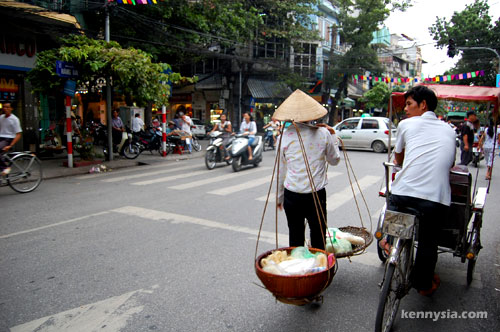
Cone hats are back in fashion
There is not a single McDonalds or 7-Elevens in sight, but that’s a good thing. Highrise buildings are also non-existent here.
While KL, Singapore and Jakarta are competing to become the next New York City, Hanoi sets itself apart with a graceful touch of old town charm normally lost in big cities.
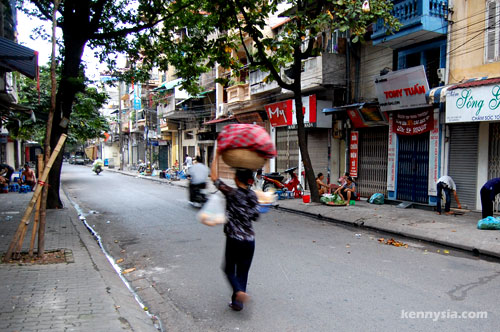
Aunties with necks stronger than your momma
We based ourselves at the Old Quarters, which is a great place to watch the city burst into life and activity. The soundtrack to Old Quarters is a never-ending music of the clanking of metals, the buzzing of chainsaws and the honking of cars. The 800-years-old marketplace is a step back in time and a great place to soak up the atmosphere here.
Meanwhile, elsewhere on the map, the French Quarters is the closest thing you can get to Paris.
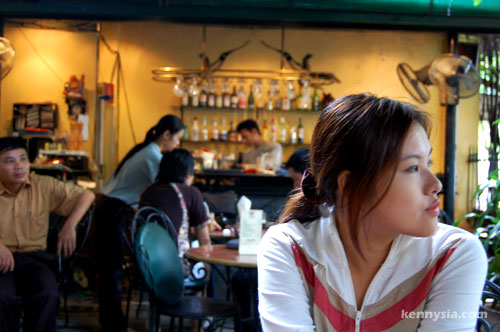
As we sit in a quiet cafe on the side of a tree-lined boulevard, sometimes we forget we’re even in Asia.
*~*~*~*~*~*~*~*~*~*
The car drivers here are almost as bad as the ones I met in Shanghai.
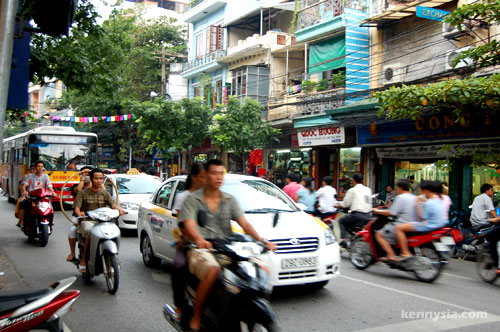
They honk like their hands are like surgically attached to the car honk. Seriously, every small thing they also wanna honk.
Got cars in front, they honk. Got cars behind, they honk. In the middle of the night when there’s absolutely no cars around, they also honk!
*~*~*~*~*~*~*~*~*~*
Vietnamese street food is truly one of a kind.
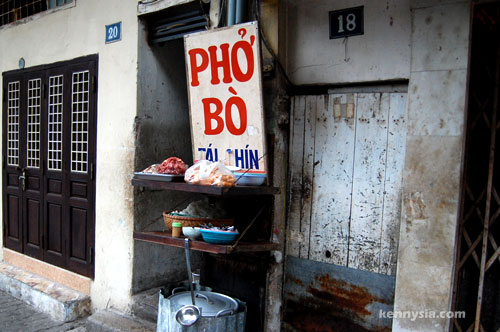
Hallo? Lu Oo Pho Bo?
Most other places would be happy to provide you with at least some decent tables and chairs for you to eat at.
Not in Vietnam.
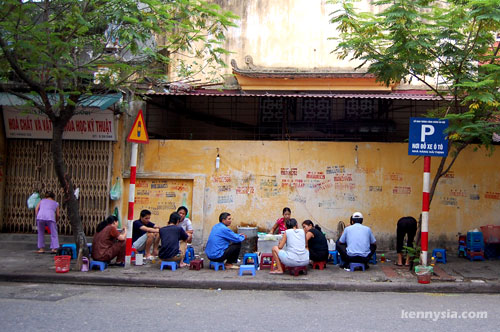
Over here, street vendors seem content providing with you tables and chairs that are SO RIDICULOUSLY SMALL, they look like they bought them from a toy shop.
I don’t know what they’re thinking. But they must’ve thought our asses stopped growing since kindergarten.
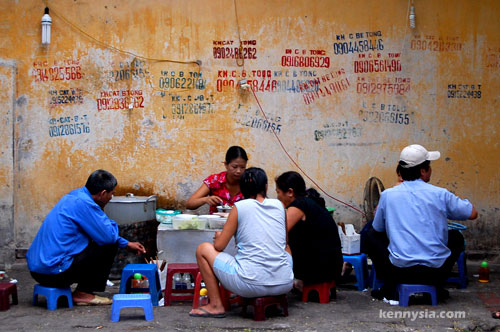
Yet, despite having to sit on freaking small toy chairs, a lot of locals seem to enjoy crowding at this particular joint.
And you know what they say. If the locals love it, it must be good.
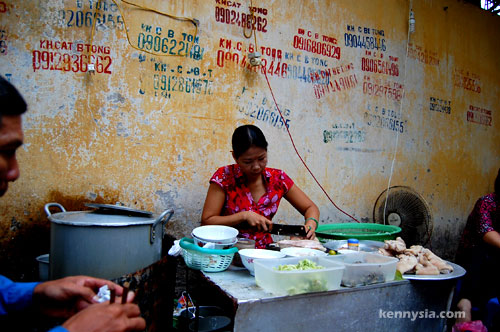
Turned out I wasn’t wrong.
For just 10,000 dongs (RM2), the nice lady cut up the meat on the spot and I got a nice big bowl of classic Pho Bo (beef noodle soup) to feed my hungry stomach.
It may not look like the cleanest most hygenic eatery, but the food here is to die for.
Ok… maybe not. Because it’s not worth losing your life over a bowl of RM2 noodles.
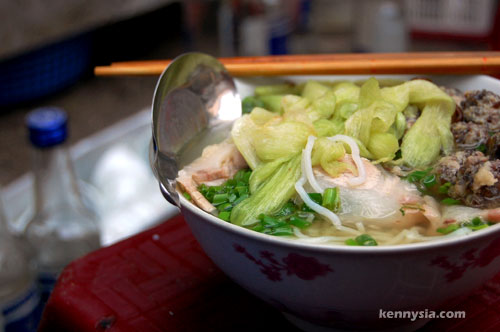
I love it. After growing up loving Vietnamese food for so long, I finally get to sample the real deal.
If you feel like drinking a bit of alco, they even serve cheap Hanoi Vodka. It’s perfectly alright to drink freaking vodka for breakfast in Vietnam.
I totally enjoyed the streetside food experience. The only problem I had was still their tiny chairs.
I know I’m supposed to semi-squat and eat with my legs wide open and balls hanging out.
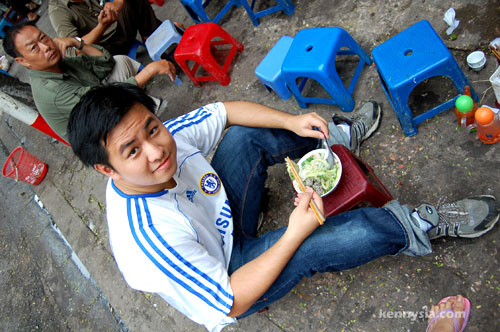
But I am so fat, I couldn’t even bend me knees!
*~*~*~*~*~*~*~*~*~*
Lonely Planet has been my favourite travel bible for many years, but I learnt the hard way not to rely on it too much. The information in there can be so terribly out of date.
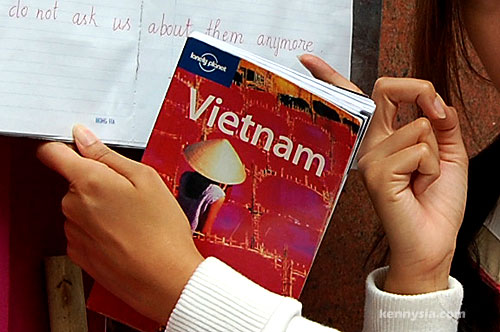
We were looking for this delicious-sounding cafe called Chocolat & Baugette located at 11 Cha Ca Street.
After searching high and low, we stumbled across this sign inconspicuously hanging where the cafe is supposed to be.
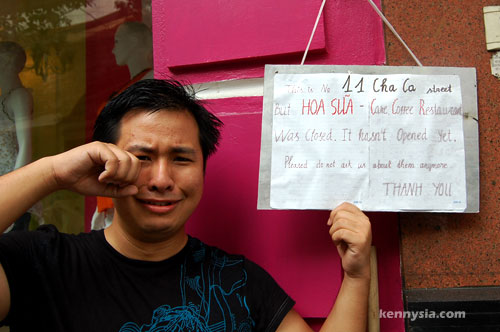
“This is 11 Cha Ca Street. But Hoa Sua Cake Coffee Restaurant was closed. It hasn’t opened yet. Pleased do not ask us about them anymore.
THANH YOU.
Sucker.”
(I added the last part in.)
*~*~*~*~*~*~*~*~*~*
*~*~*~*~*~*~*~*~*~*
This is Nicole, using my laptop to update her blog at 5am in the morning.

Yes. I know what you’re thinking.
I think I can see the title poster for the next B-Grade Korean horror movie already.

Coming soon to a cinema near you.
*~*~*~*~*~*~*~*~*~*
This is ka fay sua da, otherwise known as Vietnamese iced coffee.
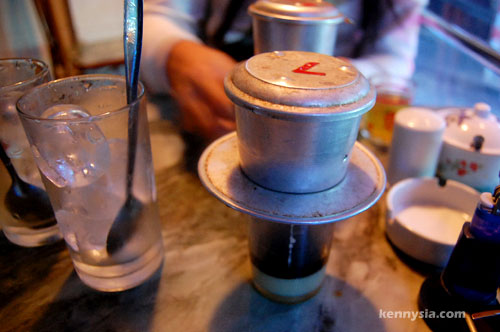
When I took a sip at this drink for the first time, my eyes widened, my arsehole tightened and I was bouncing off the walls. That was the strongest iced coffee I’ve had!
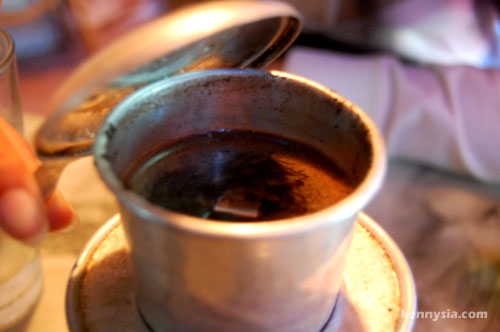
All they gave us was a glass of condensed milk with a weird contraption on top. All it contained was ground coffee and a dose of hot water. But what passed through the filter, dripping into the glass below was ounces of pure coffee heaven.
It’s the Asian version of espresso, it’s so rich with caffeine kick and it’s cheap as hell.
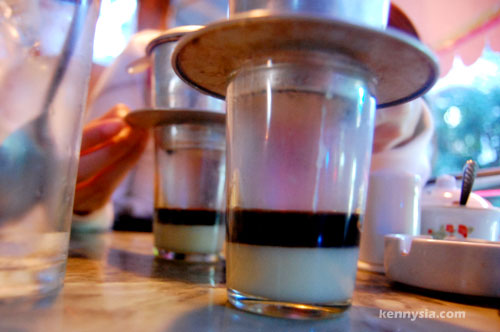
Someone has gotta import this thing here.
We may have spent 4 days in Vietnam, but when we returned, the only Vietnamese word we could speak was ka fay sua da!
*~*~*~*~*~*~*~*~*~*
The water puppet show is a waste of time.
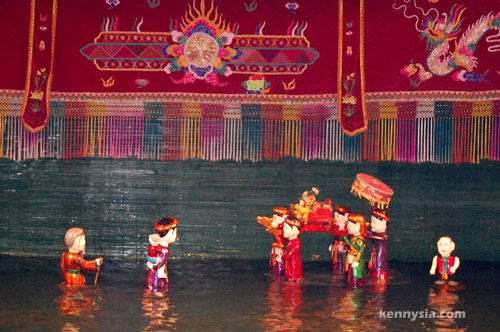
It’s cool and all that, but when the narration is all in Vietnamese, what’s the point?
Not like there’s a button that we can press like in DVDs to get the English subtitles.
*~*~*~*~*~*~*~*~*~*
This is me posing in front of the legendary Nguc Son temple on Hoan Kiem Lake.
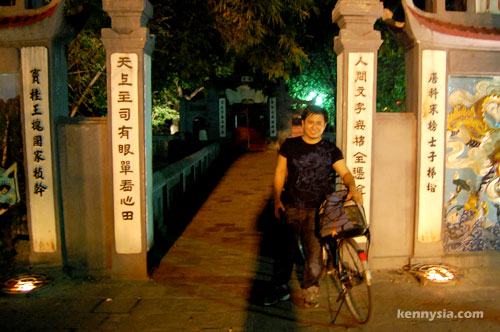
This is me looking like a dork and picking up my bicycle after it fell over.
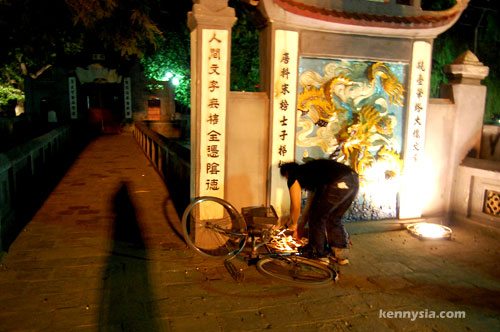
What’s worse, my bike fell over some joss sticks an old auntie left there for Hungry Ghost Month.
Sorry ghosts!
*~*~*~*~*~*~*~*~*~*
One restaurant that’s definitely worth visiting in Hanoi is Restaurant Bobby Chinn’s, the baby of that World Cafe Asia host from Discovery Travel and Living.
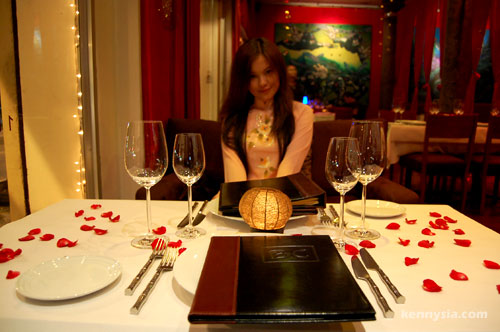
If not for the orgasmically juicy good food, then at least for the quirky and ingeniously worded menu.
It’s not cheap though. The two of us managed to rack up a bill of US$40 each, which is alright for a once-in-a-while indulgence.
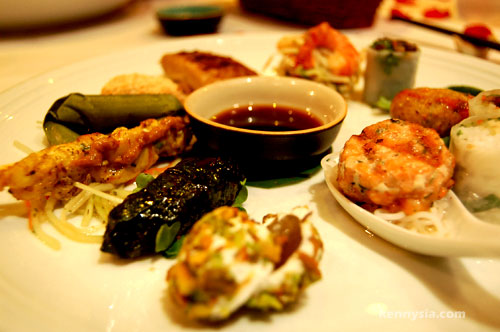
But it was worth it because this is one of the best fine-dining restaurants I had dined in in a long time. My appetiser, the Tropical Seafood Ceviche, has the kind of magic that bursts flavours in your mouth.
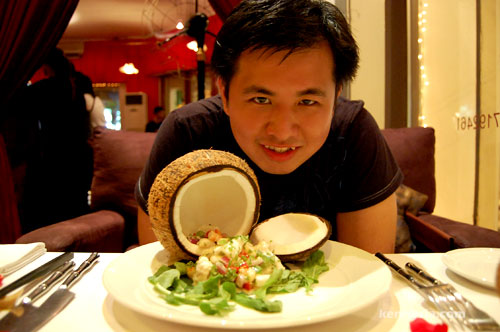
Of course, it’s only befitting that my food is served in a coconut as a tribute to the size of my testicles.
*~*~*~*~*~*~*~*~*~*
Disaster struck when we left Bobby Chinn’s.
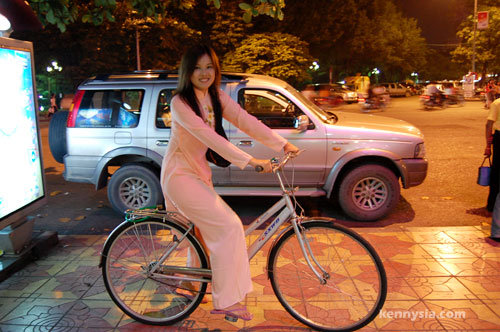
Nicole wearing a pink ao dai (US$10 / RM35 only)
Vietnamese people drive without a care in the world. Road rules are for decoration and zebra crossings are nothing but graffiti on the road. There are tens of other people fitting into the same lane as you. The unspoken rule is that you just cycle slowly, stay on course and others will avoid you.
That doesn’t always work, especially when you’re trying to cross a busy intersection where bicycles, motorcycles and cars all zoom past you so close you can feel them against your knees. In a situation like this, the last thing you wanna do is PANIC.
Which is of course exactly what I did.
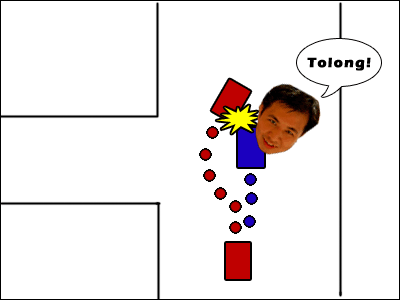
A motorcycle overtook me from behind. In the heat of the moment, I lost my balance, collided into him, fell onto the ground as a car whizzed by me, narrowly missing my head and turning me into a bloody pulp.
I survived (of course), suffering injuries no worse than a sprained wrist and a bruised kneecap.
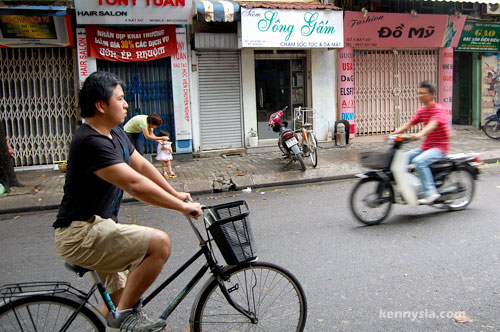
But as they say, “once bitten twice shy”.
The followed day I decided to play on the safe side and cycled as slowly and as carefully as I could…
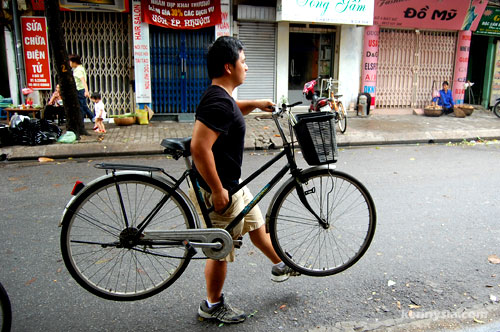
Screw it, I’m walking instead.
Known as the snake village, Le Mat has gotta be one of the most bizarre places I have encountered in my travels.
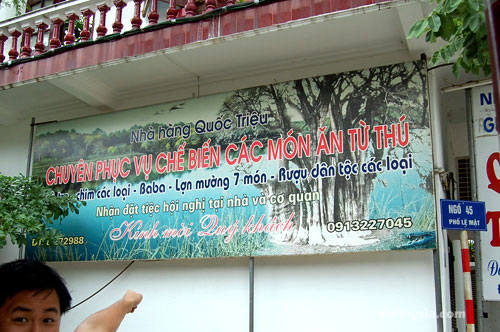
Le Mat is a village located 15 minutes east of Hanoi and is famous for their snake catching and breeding tradition. In the olden days, villagers of Le Mat were snake experts called in to remove those poisonous serpents from all around the region.
But with the modernisation of Vietnam (and presumably lobbying of animal rights groups), this practice has gradually died down. In its place are snake breeding and the dozens of snake restaurants scattered around here.
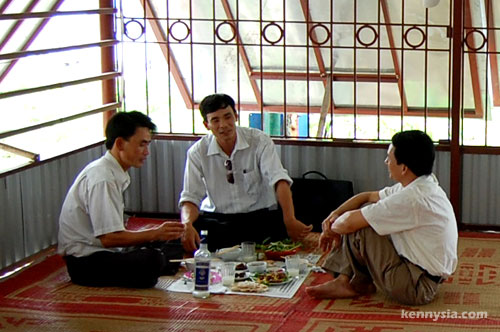
A dog meat restaurant at Pho Nghi Tan. I didn’t eat hor! I just watch other people eat only.
Vietnamese people have strange taste buds for dishes not usually found on Malaysian dinner tables. While it may appear to us that eating certain animals is “wrong” or “cruel”; in Vietnam, there’s nothing “wrong” or “cruel” about eating anything that could sustain the body.
As long as its legal, those Vietnamese would savour whatever animals they could lay their hands on.
Snails. Grasshoppers. Cats. Dogs. Snakes. Rats. All the twelve animals on the Chinese Zodiac.
Heck, if the Dragon existed, I’m pretty sure the Viets would eat it too.
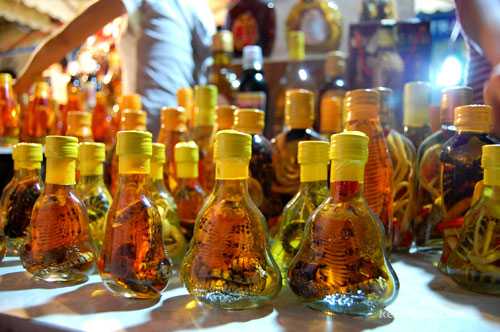
Cobras are especially popular in the Vietnam culture, even more so than dog meat. As much as snakes are considered taboo food in our cultures, they are as common as chicken or beef in Vietnam.
Bottles of snake wine, like the one pictured above, are openly sold in markets all over Hanoi and Sapa. They come in various forms and sizes, from tiny little Hennessey bottles costing just 15,000 dongs (RM3) each to 300,000 dong (RM60) ones which have ginseng, scorpions, geckos and even seahorses included as part of the ingredients.
They said it’ll give my kukujiao the extra oomph, but I don’t believe that.
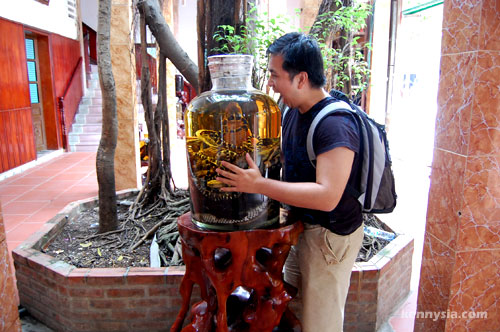
Regardless on your personal beliefs on what types of animals are taboo and what is not, a trip down to Le Mat is guaranteed to be an experience both bizarre and interesting at the same time.
If you can stomach your fear, that is.
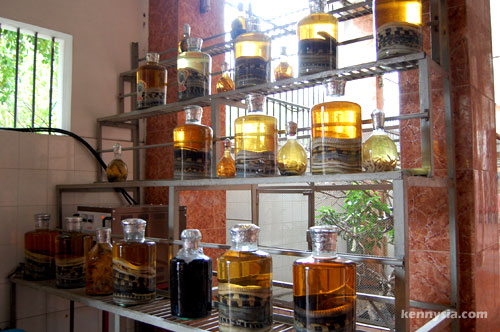
We went to one restaurant called Quoc Trieu, which was highly recommended by a German expat we met on the boat in Halong Bay.
The restaurant itself is two-storey high. The main dining area is on the top floor whereas the ground floor is where they rear the snakes.
Walking through the entrance, I felt like I was in some creepy high school Biology lab. On display were hundreds of large jars and vats, each with 3 or 4 poisonous snakes, all neatly coiled and fermenting inside the yellowish rice wine.
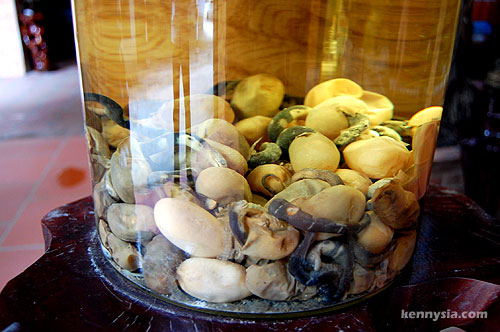
Some displays were pretty gruesome. There was one with snakes eggs, freshly hatched with the baby heads just popping out.
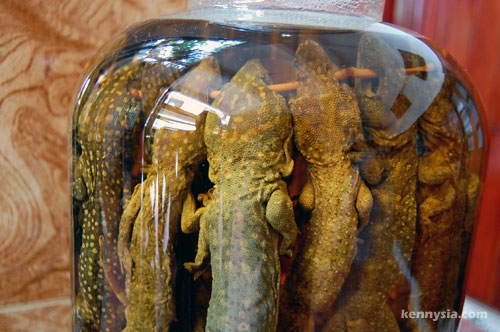
Then there’s this hideous bunch of lizards looped together with a stick through their eye sockets. Not a pretty sight,for sure.
When the animals are fermenting inside rice wines, they live and kicking behind glass windows. The restaurant looked like an exotic pet shop. Except people don’t buy those animals to keep as pets.
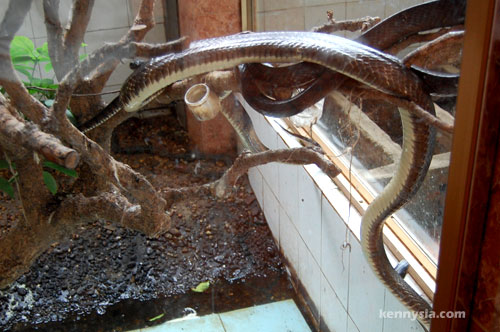
Being a snake restaurant, there are of course hundreds of live snakes slithering around.
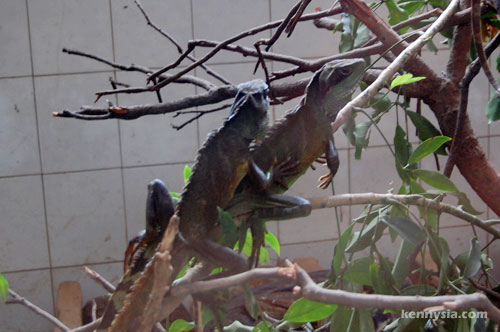
Iguanas making love.
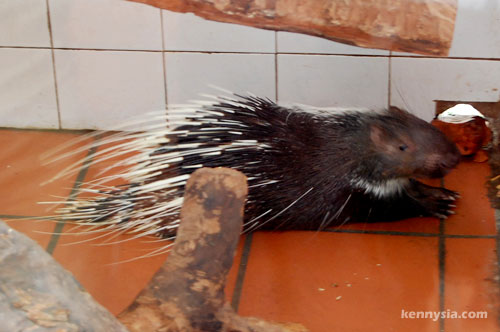
And even porcupines crawling around their cage.
Mind you, these creatures may be considered exotic in Malaysia, but they are all perfectly legal in Vietnam.
The sight of these animals waiting to be made into stew is starting to make me feel a little uneasy. But nothing could prepare me for the most evil, disgusting and repulsive sight of all.
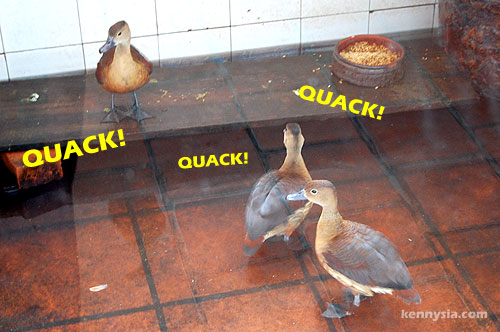
DUCKS!?
What the hell are ducks doing in a restaurant like this?!
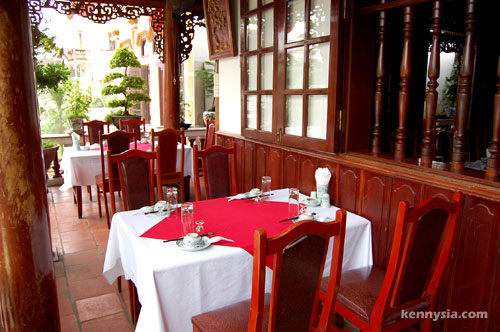
Nicole and I were ushered to the top floor. In contrast with downstairs, the decor looks great here and the interior is nicely spiced up with intricate bonsai plants.
If it weren’t for what we saw downstairs, we could well be mistaken for entering a upper-class Chinese seafood restaurant in Malaysia. The difference is, in Malaysia we have live fish, prawns and lobsters swimming in the aquarium tanks downstairs waiting to be cooked. Over here, they have cobras.
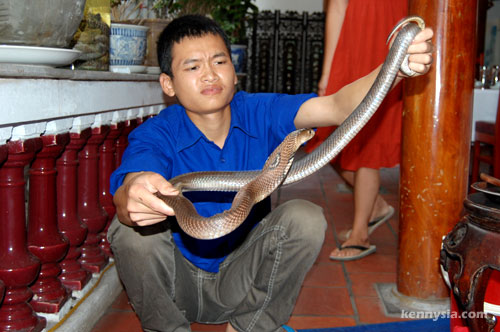
We ordered the smallest-sized cobras good enough for two. The bill didn’t come cheap at 700,000 dong (RM140), but I probably should’ve bargained.
A short while later, the man in blue brought out this live, slithering little cobra.
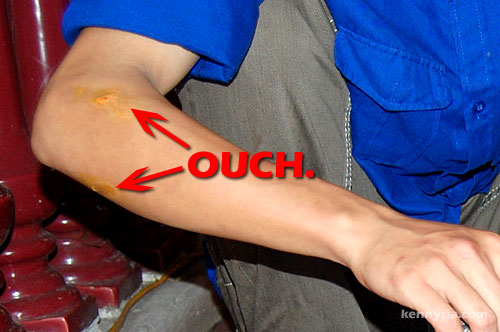
Looking at the multiple bite marks on his arm, it’s not difficult to imagine exactly where he got those wounds from. This villager of Le Mat must be so used to being bitten by cobras, he’s probably immune to the venom by now.
Or maybe he’s mutated into part-human part snake already. I’m pretty sure if he took off his pants, we’d be greeted by the sight of a vicious one-eyed snake.
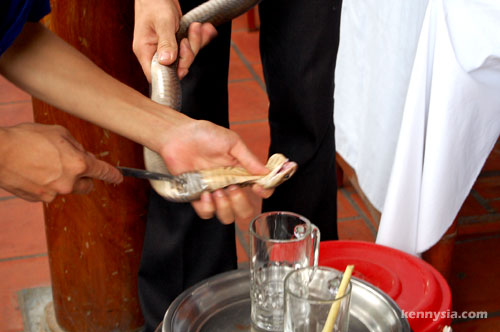
The cobra was killed instantly with a quick incision down it’s main arteries.
First, he drained its warm blood (or was it cold-blooded?) into a glass of rice wine. Then he removed the gall bladder, and emptied its bitter contents on another glass.
Finally, he cut open the belly of the snake and carefully placed its heart, still beating, on a plate before my eyes.
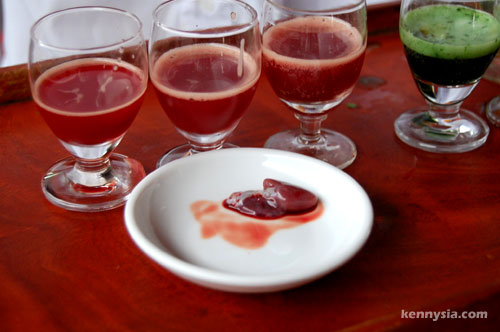
I looked at the waiter as he poured the organ down the glass mixture of blood and rice wine. I have never been so equally disgusted and terrified at the same time since the last time I pooped in my pants.
“This is it, “ I said to myself as I lifted the glass.
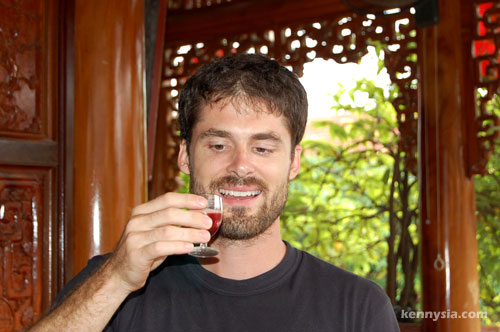
It was like participating in a real life episode of Fear Factor.
In one swift movement, I closed my eyes, opened my mouth, tossed my head back and let the still-beating heart and blood slide down my throat.
“Ewwwww!”
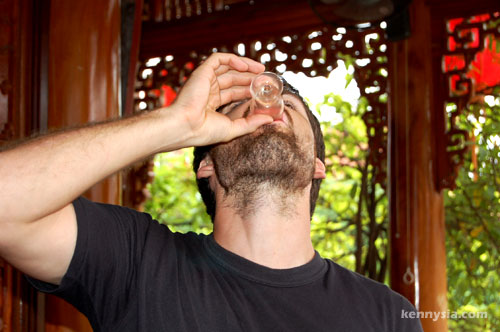
How did it taste like? Very, very strange.
It all happened really quickly. But when I chugged down the vampiric mixture of blood and beating heart, it tasted like a strong shot of Tequila, with a piece of Nata de coco going down my throat.
Maybe its the thought of having swallowed a heart, or maybe it was the alcohol, but I was getting a lil queasy. I felt like puking, but I didn’t want people to think that I puked my heart out.
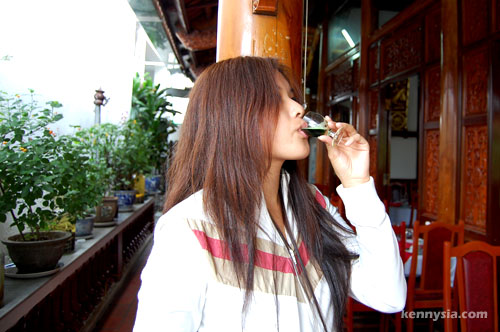
The greenish liquid snake bile was equally difficult to swallow, literally.
Nicole described it as tasting similar to bitter gourd, or wheatgrass. As weird as this might sound, it was actually quite good.
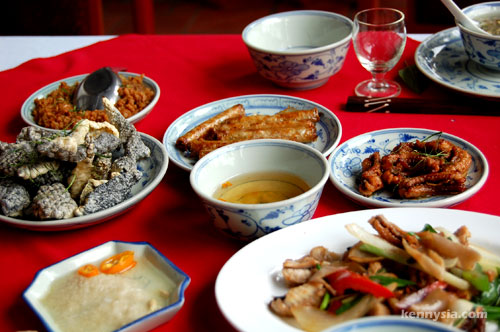
Luckily, lunch was served soon afterwards.
We were served about seven dishes of the snake cooked in various ways. And to be honest, it wasn’t all that bad.
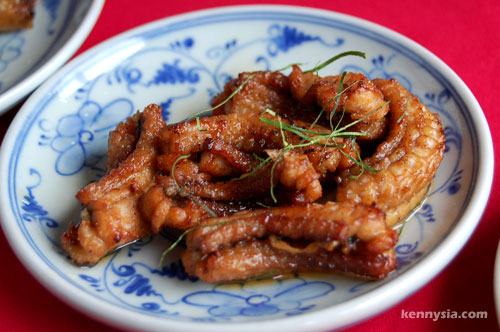
There were snake soup, snake meat in spring rolls, snake in sushi, grilled snake, minced snake, stir-fried snake (which tasted like octopus), and even deep fried snake skin (which tasted very much like tempura).
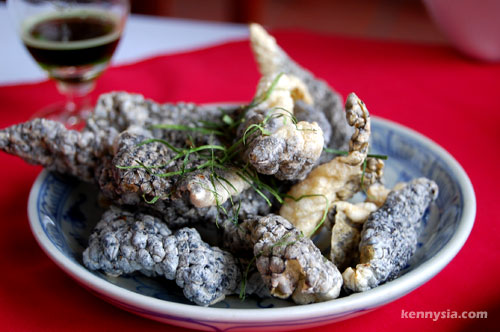
Actually if you didn’t think about it, they pretty much tasted like chicken.
I would’ve enjoyed the feast quite a lot if I wasn’t still so shaken up over what just happened. The rice and cucumber were the only two dishes I was comfortable eating.
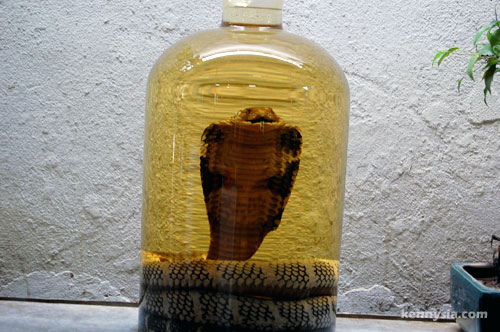
We left Le Mat feeling disturbed and a little strange in the stomach. This definitely isn’t something we’d like to repeat again. But one thing for sure, that was one helluva experience.
At least for once, we can now tell people that we had snakes for snacks.
*~*~*~*~*~*~*~*~*~*~*~*~*
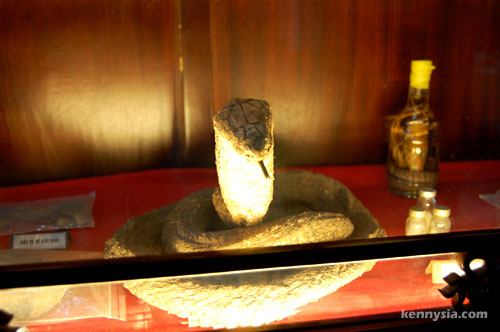
Before I end this entry, I think I probably owe some people an explanation as to why I did what I did in my last video.
It’s always easy to condemn when you don’t understand. So please, put down your pitchforks and listen to what I have to say.
I’m not gonna lie. A big reason why I did it was because I was curious about it.
I’ve read about the Vietnamese snake-eating habits on Lonely Planet, travel blogs, and even AirAsia’s inflight magazine. Only after my conversation with the German expat we met on the boat that I decided to explore it. We’re in Vietnam, and this is after all a once in a lifetime chance.
Curiousity killed the snake.
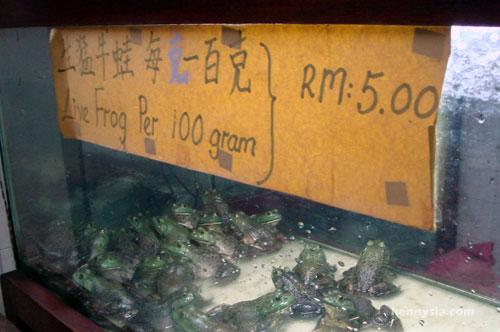
Live frogs for dinner, in Kuching
A second reason why I did it was to challenge my fear of eating something outside my comfort zone. Even back in Kuching where dishes like duck tongues and frog legs are common, I’d be too chicken to try it.Gimme chicken anytime.
You can ask naeboo. She served me bat meat once and I ran away screaming like a girl.
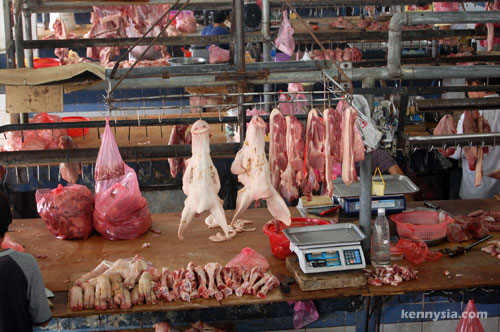
Wet market in Kenyalang Park, Kuching
I can understand why people are upset. Because let’s face it, that video was damn sick. In fact, I would have been even more disturbed if people did not get angry at me.
A lot of people was upset because they thought it was animal cruelty. They assumed the snake was alive when it was cut open. If the heart was still beating, it must still be alive, right?
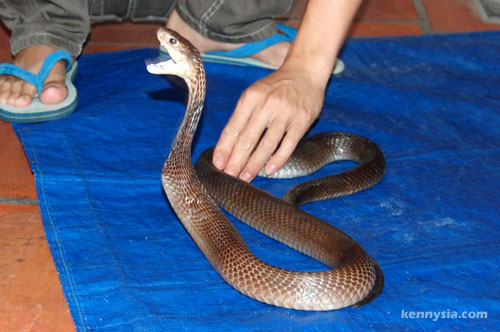
Like I said, it’s easy to condemn when you don’t understand.
The proven medical truth is the cobra was killed instantly by the first incision to the throat. Veterinary students can correct me if I’m wrong, but when the blood supply to the brains were shut, the animal would be dead too quick for it to register any pain. There was no torture. There was no slow painful death. It was HUMANE.
This method of slaughtering is also similar to how Halal meat is prepared. Killing the snake that way was no less inhumane than the slaughtering of cows or chickens that contributed to your daily diet.
Slaughtering of chickens the non-Halal way is even worse.
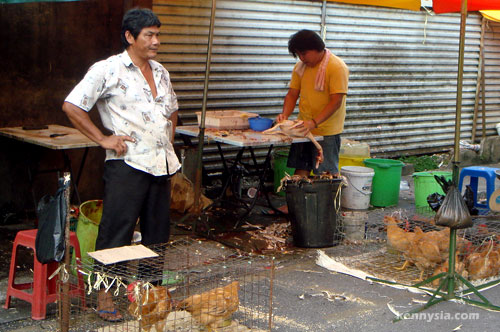
Slaughtering of chickens in Satok Market, Kuching. You can watch a live show here every Sunday.
Some said I shouldn’t blogged about it.
Come on, I have already toned down A LOT over the past 2 years to cater to people’s criticisms and sensitivities. At least let me have my freedom to blog at my own blog. Any further restrictions and I might have to rename my blog notkennysiadotcombutkennysiapunyareaderpunyablog.com.
Then you’re gonna have fun typing my URL.
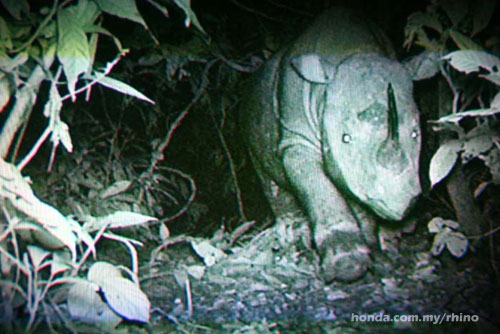
Some accused me of being a hypocrite because I had cobras for lunch on one hand, while on the other hand I support Honda-WWF’s Save Our Sumatran Rhinos campaign.
How can you compare cobras with Sumatran Rhinos?
One is a common animal that is farmed, bred and reared on site specifically for human consumption. The other is an endangered animal that roams in the wild and suffers losses of habitat due to deforestation.
One is legal to own. The other is not.
I did not eat a Sumatran Rhino. I ate cobra.
Cobras are not endangered in Vietnam. So how am I contradicting myself?
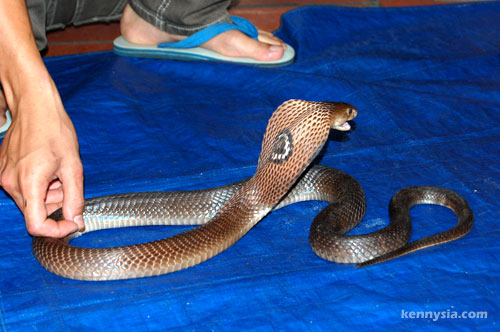
The only aspect about the whole thing that made me feel uncomfortable was watching the cobra killed in front of me. That is why I said I don’t condone it.
As a matter of principle, I try not to consume any living creature have to die immediately before cooking. For that reason, I seldom eat at Chinese seafood restaurants where they take live fish or prawns out from the aquarium tanks and cook it to order.
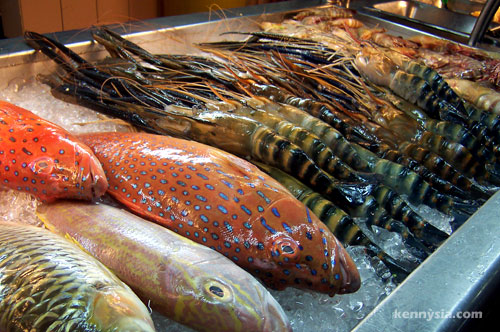
Live fish left to slowly and painfully die on ice is also torture
Of course, I make exceptions during rare cases. Eating the cobra heart was a once-in-lifetime-thing for me. Having done it already, I can tell you that it tasted nothing special. For that price, it ain’t worth it. So decide for yourself whether or not you wanna try.
I’d like my critics to answer me honestly if they have never been guilty of eating at live seafood restaurants before.
Just because they killed the fish and prawns alive in the kitchen doesn’t make it anymore humane, correct? Or was it a case of “ignorance is bliss”?
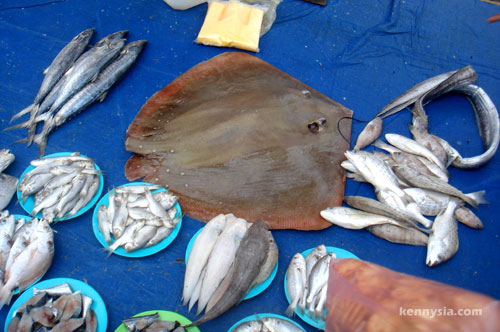
Satok fish market, Kuching
Then finally there are those who said what I did was wrong eventhough the cobra is not endangered, is reared like a chicken, and is killed in the most humane way possible.
They wanted me to convert into vegetarian.
I’ve got nothing against vegetarians. If you think eating meat from any type of animal is cruel, then kudos to you.
But what I hate MOST are vegetarians who think they are better than me, just because they like to eat their stupid soy and tofu.
Look, I tried going on a vegetarian diet before. It didn’t work out.
I know you think eating chickens and pigs and snakes are cruel.
But for the love of me, I cannot imagine eating Big Mac without meat.
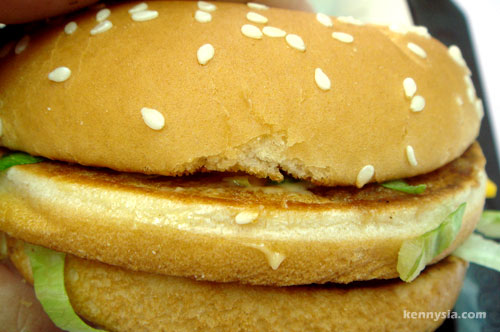
Kueh Chap without pork.
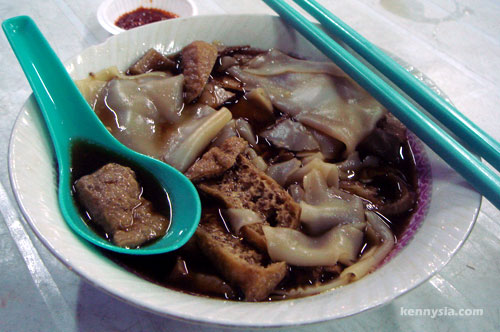
Or worse…
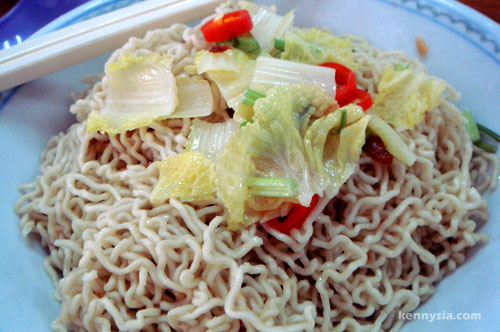
KOLO MEE WITHOUT CHAR SIO!
This is also a form of animal cruelty. It’s called Kennysia-cruelty.
I might as well just die.
I heard Vietnamese people have a penchant for exotic food, but I wasn’t prepared for this.
Warning: This video may offend.
The only reason why it’s here is because it’s something you don’t see everyday.
I am prepared for negative comments. Before you condemn me to hell, let me go on record to state that I do not condone my own actions in that video clip. That was the first and last time I had done what I did, and I will never do it again.
After two noisy nights inside a rumbling train, my travel partner and I are looking forward to some peace and quiet.
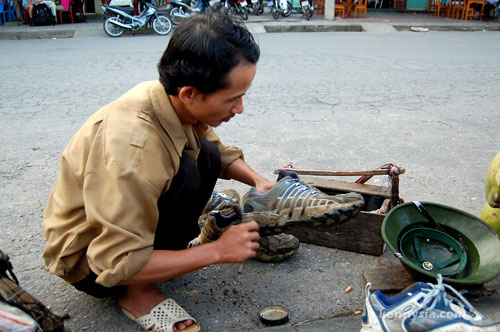
Mobile shoe-cleaning service, only US$1 / RM3.50 each
Nicole didn’t sleep well. The night before, she was sharing the cabin with three men playing The Symphony of Snore-chestra all night long. And I was one of band members. Hehe.
Anyway, on the third day of our trip, we returned to our Hanoi guesthouse. Without much rest, we signed up for an overnight tour of Halong Bay.
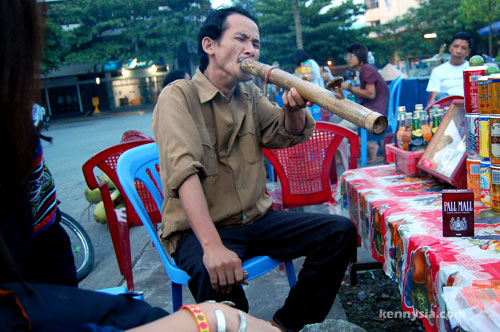
Mobile shoe cleaner using the money we paid him to smoke tobacco pipes
As much as I’m normally anti-tour agents, US$50 (RM175) all inclusive is a pretty good deal. It’s nice for once to let someone else do the planning and just sit back and relax.
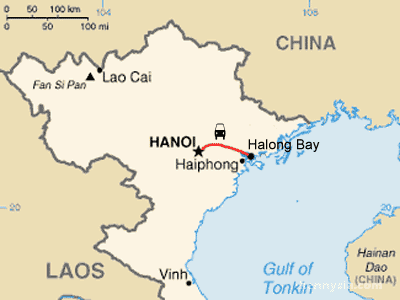
The two of us were joined by eight other travellers from other parts of the world. Together we departed for Halong Bay at an ungodly hour of 8 in the morning.
Halong Bay is located 4 hours east of Hanoi by bus.
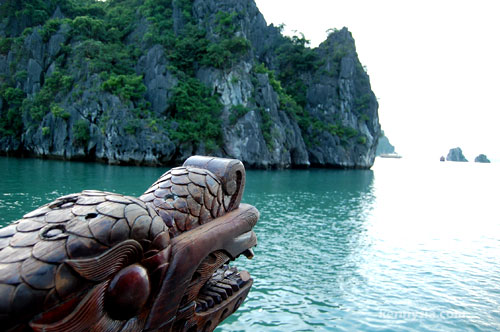
From there, we boarded our traditional wooden junk boat and checked into our cabin.
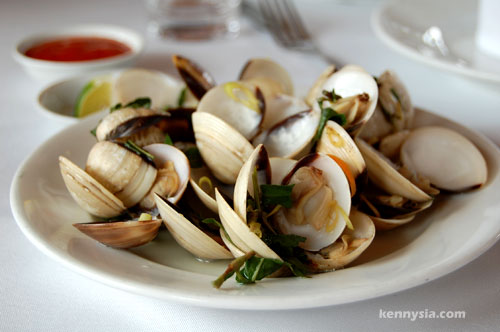
The boat sailed out and we were served our welcome lunch, which was a fantastic Vietnamese seafood fare.
The first meal was the best meal of the boat trip. Too bad after the good first impression, the meals got crappier and crappier each day.
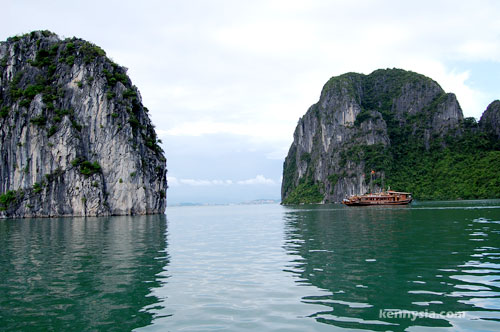
Unlike Sapa, Halong Bay has long been commercialised and developed as a tourist destination. It may not have the warmth of the minority tribes, but development has made the place accessible and the rates between tour operators competitive.
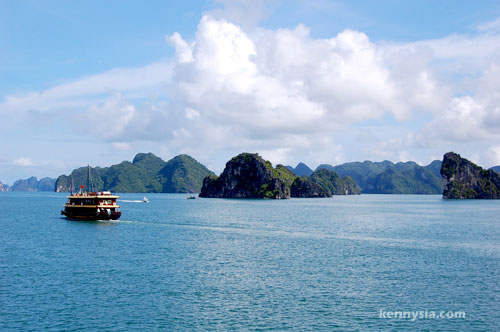
Halong Bay is a natural wonder, a world heritage site and a top attraction for visitors to Hanoi.
The area is famous for their awesome limestone karst formations rising above the sea, dotted around its bay. It’s every photographer’s dream and I must admit I was impressed.
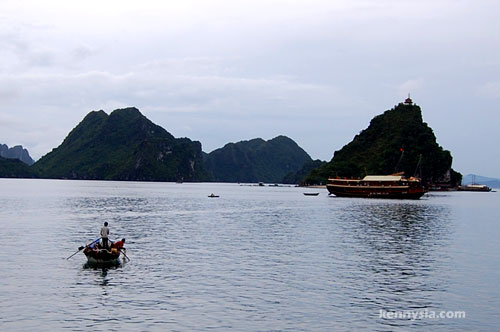
An overnight stay on the boat at Halong Bay is an experience I highly recommend. There’s nothing more serence than waking up on a gently rocking boat amidst the morning drizzle surrounded by karst limestones.
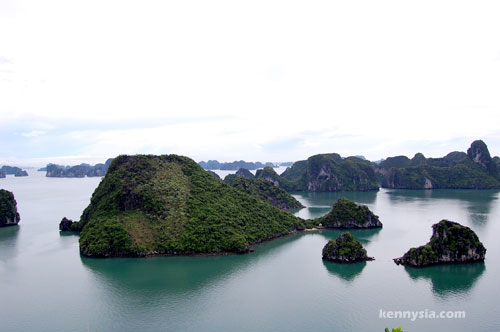
We were lucky to depart on a clear blue day. The water was beautifully emerald green, shimmering in the sunlight. Sitting on the top deck with our new friends, we had fun watching one island pass by after another.
Some islands have more character than others.
Like Titop Island.
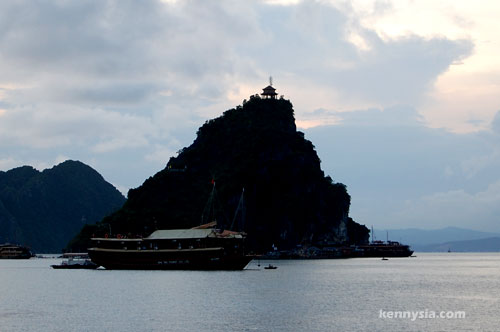
Legend has it that once upon a time, there lived a Very Old Man meditating inside that pagoda on top of the hill.
In the past, people used to climb that treacherous hill looking for that Very Old Man. When they finally reached the pagoda, they would kneel down before him and yell “SIFU!” while the Very Old Man stroked his long white beard and chuckled.
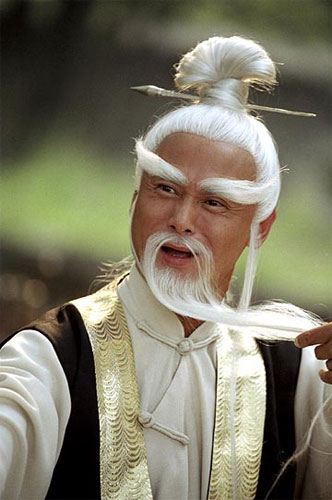
The Old Man would torture them for seven days and seven nights before teaching them kung fu and turn them into the next Bruce Lee.
…
Unfortunately, that was actually just some bullshit story I simply made up. There’s no Old Man living on the hill top teaching kung fu.
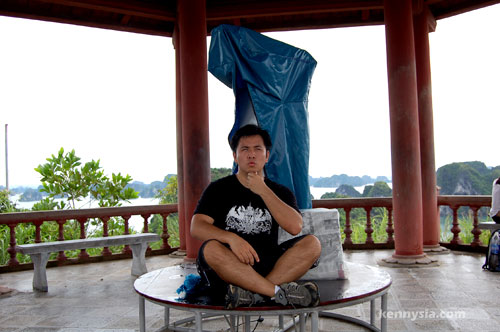
The views on top of Titop Island is beautiful, but all there is is just some hairy Kuching dude sitting there acting stupid.
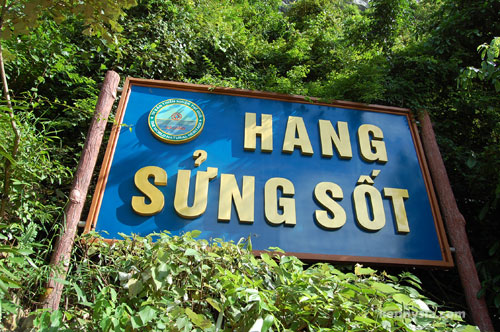
During the tour, we stopped by one of the many islands to check out the limestone caves.
It was alright , although I’m sure *cough*Sarawakhasbettercaves*cough*. They even had paved walkways and illuminated rock formations with coloured spotlights for the convenience of tourists.
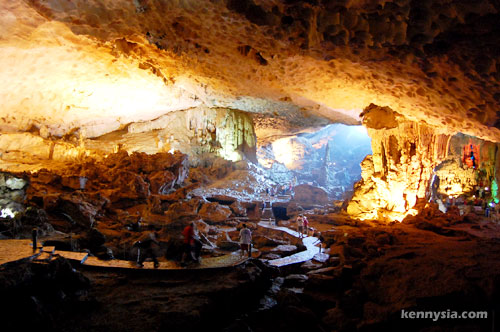
It wasn’t all that exciting.
This is the only rock formation worth seeing inside the cave.
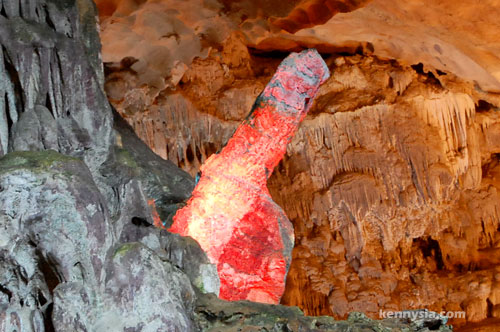
Looks more like the “rock formation” you can see in my pants.
The guide says it’s a “finger”, but I beg to differ.
Fingers don’t have testicles.
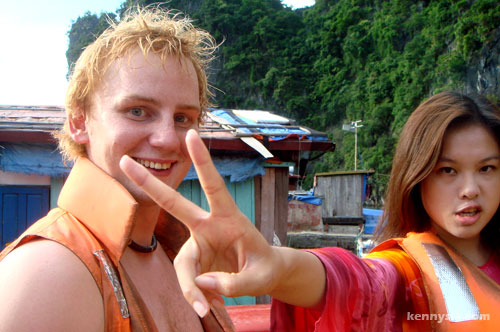
In the afternoon, the guide arranged for us some kayaks to get our fat asses working. Kayaking is excellent in a beautiful place like Halong Bay.
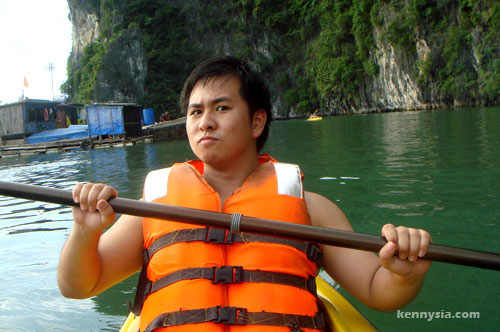
Unker Francis Ho must be proud to know that we were the slowest of them all and consistently ended up last among the group.
But don’t blame me! How the hell am I supposed to concentrate when my buddy was paddling like this?
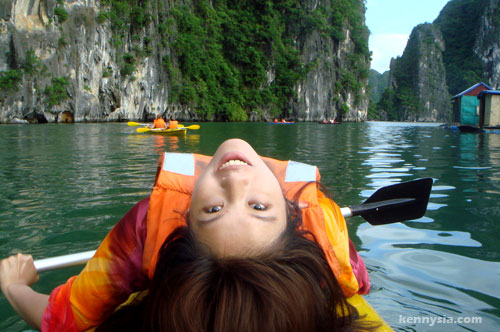
Ridiculous.
Somehow we miraculously managed to manoeuvre the kayak and had a short tour around the area. We paddled through a small tunnel and looked at some rocks looking back at us.
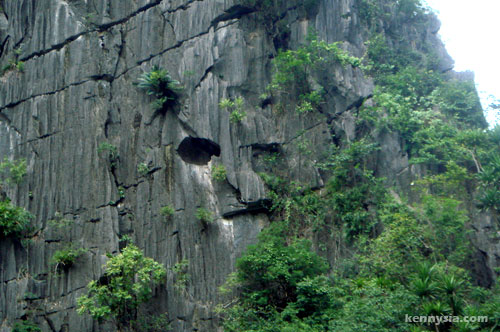
It was surreal. We felt tiny surrounded by monolithic limestones circling us.
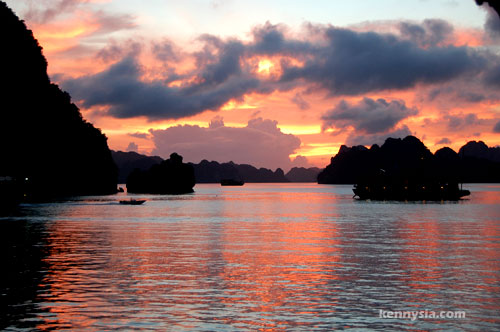
The highlight of our trip was watching the sunset in Halong Bay from our boat.
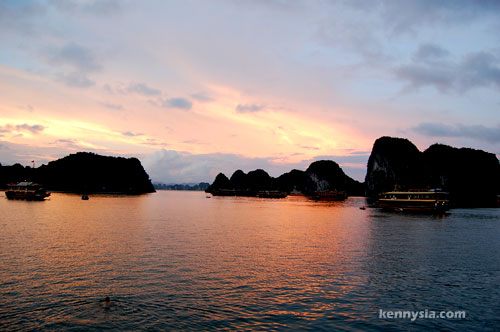
It was simply sublime. There’s something breathtaking about watching the colours of the water change to red as the sun sets.
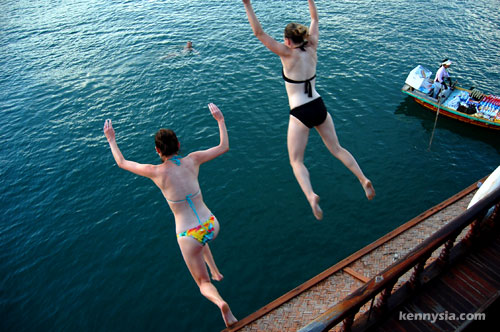
Against the backdrop of limestone silhouettes, the more daring ones among us decided to have a dose of adrenaline rush by jumping off the boat and plunging into the water.
It looked fun.
Some even did amazing backflips off the top deck.
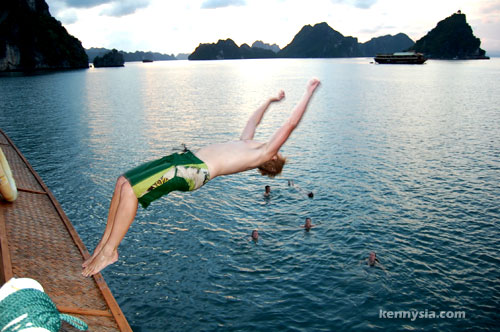
AWESOME.
Made me feel like joining them also.
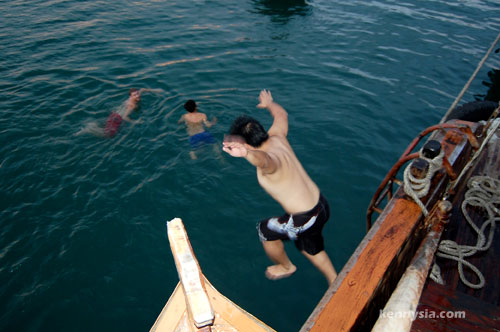
I believe I can flyyyyy
Don’t laugh. I SAID DON’T LAUGH!
Our adventure in Vietnam didn’t actually begin until 12 hours after we touched down at Hanoi.
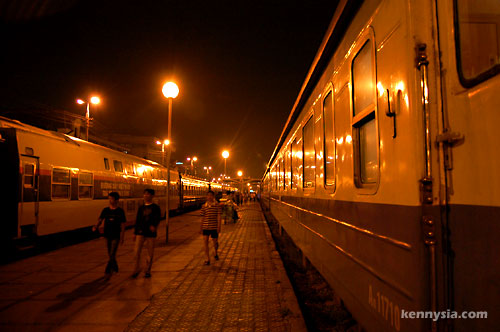
From the airport, we took a 45 minute taxi ride (US$10 / RM35) to Hanoi train station, passing by a stretch of Thit Cho (dog meat) restaurants along the way.
We slept in an overnight train to Lao Cai, which took 8 hours and costs us US$22 (RM77) each in a 4-person cabin. Dinner was French baguette dipped in condensed milk we bought from a tattered poor girl in hawking outside the train station.
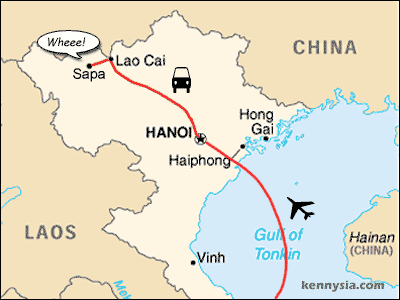
When we reached Lao Cai the next morning, we had to endure another 1-hour minibus ride (25,000 dong / RM 5) up the windy roads to our final destination – Sapa.
Finally we can begin our adventure in Vietnam!
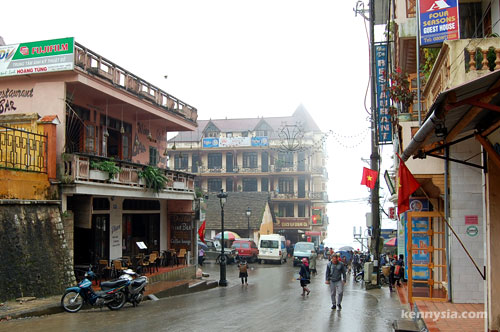
Sapa is a tiny agricultural town nestled on the mountain top near the Chinese border. It’s a little troublesome to get here from Hanoi, but our effort was worth it all.
We have arrived at the coldest town in Vietnam with the most spectacular mountain sceneries.
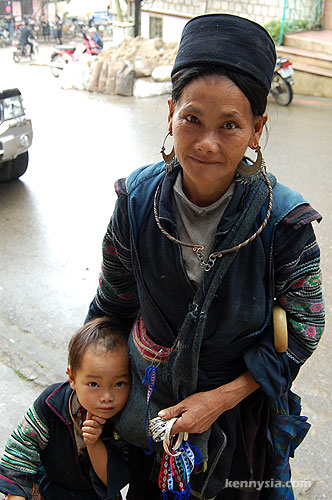
A H’mong mother and child
Sapa is an enchanting little place. It isn’t just the specatculars views that attracted many travellers to travel so far to get here. Sapa is also home to many ethnic minority tribes, the largest being the H’mong (è‹—æ—) and Dzao people (瑶æ—).
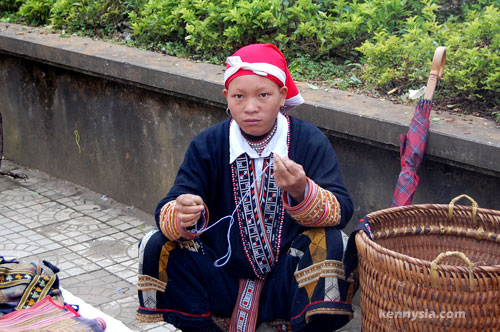
A Dzao lady (no, she’s not Santa Claus)
This is one of the very few places in world where we can still witness the hill tribes dressed in their colourful traditional clothings, going about their daily lives. Much of their culture and customs are preserved, isolated from the rest of the population in Vietnam.
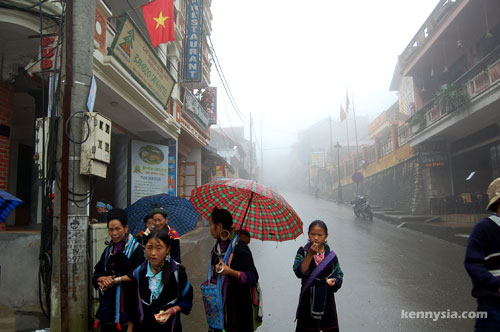
It was cold and drizzling when our bus reached Sapa. Nicole and I sought refuge at a nearby souvenir shop. I went off to buy some disposable raincoats for later use, while Nicole stayed in the shop.
When I returned 5 minutes later, I received the biggest shock ever.
Our friend had transformed into a local H’mong girl.
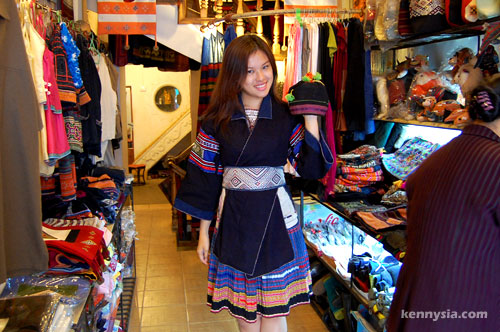
I know they say “Do As the Romans Do”, but this is ridiculous.
Kenny: “We’re going to trek mountains later you know? How are you gonna go trekking wearing a skirt?”
Nicole: “Nevermind! Can one! :D”
Kenny: “……..”
Nicole: “So cheap. RM40 only!”
Kenny: “………………….”
Somehow, I had a baddddd feeling about this trip.
Anyway, we had breakfast and strolled through the local market while waiting for the rain to clear.
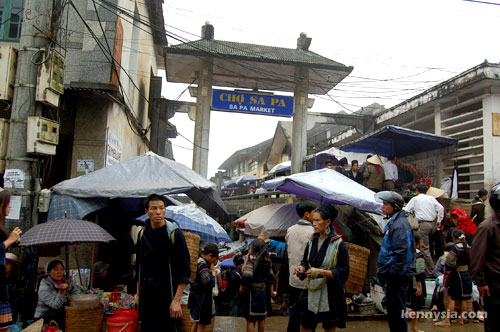
Life in Sapa is so simple and different from what we are used to. It is fascinating just sitting here idly watching life goes by. I’ve been to some fairly undeveloped rural towns before, but Sapa is the first true village experience I had.
An example would be when we were at an internet cafe checking our e-mails, and a herd of water buffaloes gently walked on by.
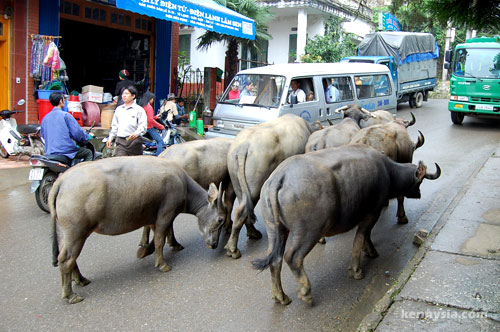
How often do you see water buffaloes walking past internet cafes?!
That was so cool! That was when we really know we’re at the countryside.
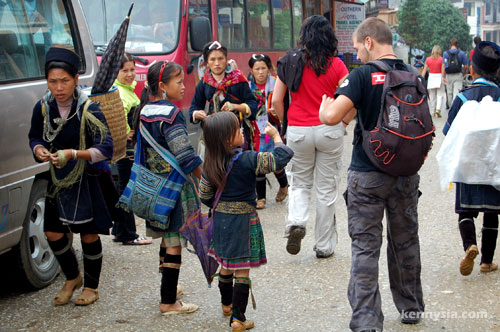
A common sight in Sapa is H’mong women persistently following hapless tourists, pestering them to buy jewellery and trinkets.
With the boom in tourism business a few years back, a lot of the H’mong women and girls had gone into the souvenir business.
We were being followed by a few during our short stay here. Some even went as far as to wait outside the restaurant where we had breakfast.
It is difficult to turn them down, especially when they are being so friendly and patient. But there’s an ugly side to everything.
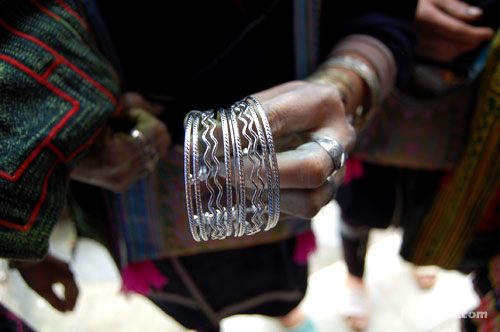
When a frail old lady approached me holding a silver bracelet in her hand, I purchased one from her out of goodwill.
Big mistake.
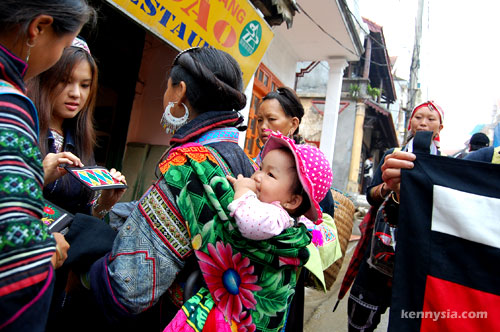
Within mere seconds, hordes of tribe women swarmed towards our direction peddling their wares.
“Look! Look!”
“Buy from me!”
“You want earlings? Nor? Hawr arbout purse?”
Now, it WOULD HAVE been quite nice if the girls looked like those bikini babes from will.i.am’s music video.
Unfortunately, reality wasn’t as kind…
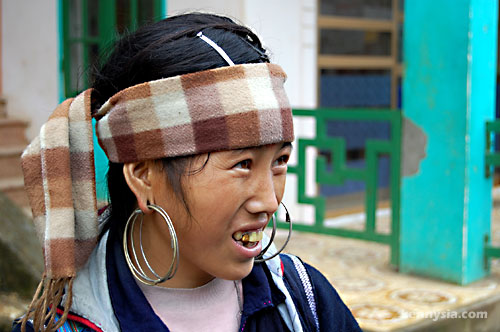
Nice gold tooth, sista
We had no choice.
WE MUST FLEE!
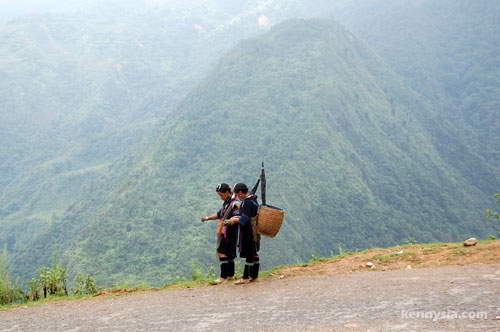
Before we knew it, Nicole and I had escaped onto the path to a H’mong village.
The ethnic minorities don’t live in Sapa. Most of them live in traditional villages around the area, coming to Sapa only to go to school or do business. The nearest H’mong village is Cat Cat Village.
Contrary to its name, there’s not a lot of cats in Cat Cat Village.
Anyway, the boy from Cat City went to Cat Cat Village.
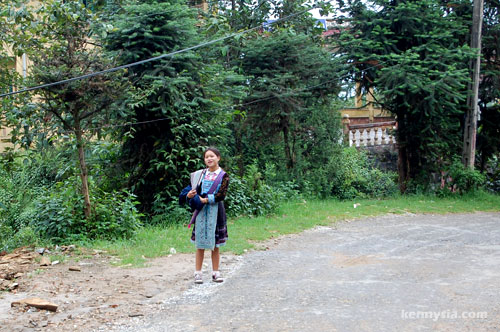
We met a 16-year-old H’mong girl called Ha along the way. This one is a little different from the rest.
Not only does Ha look way younger than the 16 years old she claimed to be, she also spoke to us in perfect English. Unlike the other H’mongs we met who are mostly shy and quiet, Ha is one loud and feisty little lady.
When she approached us, she wasn’t pestering us to buy her wares.
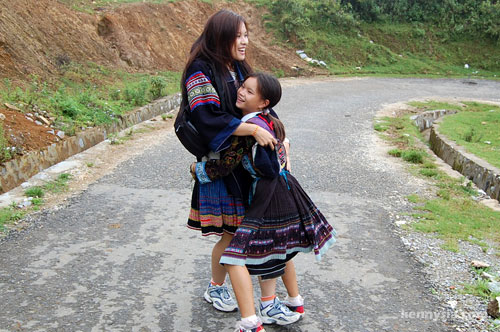
“Are you crazy?!”, she pointed to Nicole’s incorrectly worn tribal belt. “You wear your belt like this, it means death!”
And that was pretty much our opening topic.
Maybe it was Nicole’s tribal dressing, but Ha took an immediate liking to her. Ha warmed up to us and stuck with us through the remainder of our stay here.
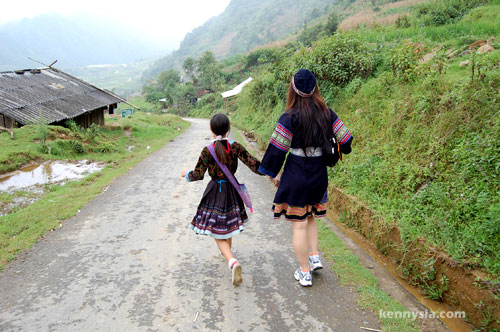
Ha liked Nicole a lot. She gave her a flower, put it on her ear, made her a crown our of fern leaf and helped tie her hair up into a pig tail.
I kinda suspected Ha didn’t quite like me as much though. All she seemed to care about is my man boobs.
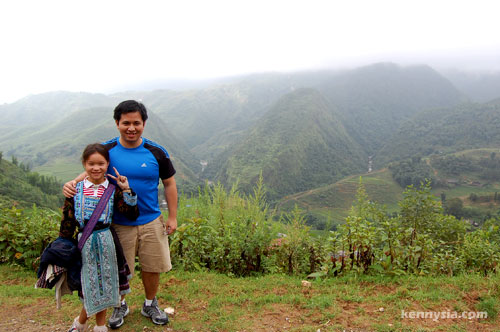
Throughout our journey, the feisty little H’mong girl repeatedly:
Yeah I’m pretty sure Ha liked Nicole better, eventhough she still squeezed her boobs and felt up her skirt.
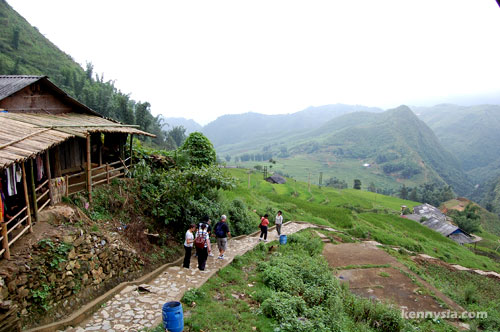
Anyway, as much as we were being bullied by a 16-year-old, it’s great to have Ha come along with us. Nicole and I didn’t wanna hire a tour guide to save money, so Ha ended becoming our impromptu guide and translator in Sapa. Not once did she try to force us to buy anything.
The hike down Cat Cat Village was easy and the sights are breathtaking. Even with the fog obscuring much of what lies in the distance, we had magnificent views over the rice terraces and small houses below.
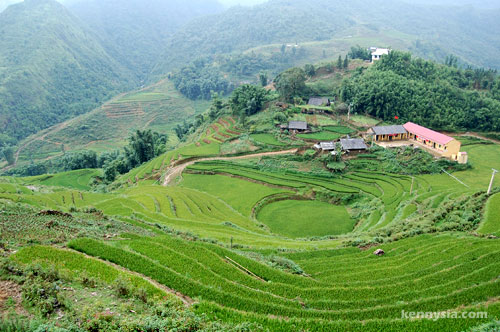
Life in the villages is as basic and simple as it can get. There are no TV or fridge or any other modern amenities that we take for granted over here. There’s not even basic water, electricity and gas supply.
Over here, the water comes from the sky, lunch means cooking freshly-plucked vegetables with charcoal and going to the loo means hiking out to the nearest bush and pee there.
There are no iPods or Xboxes. Whilst kids in Malaysia fight over the latest handphone and gadgets, kids in Sapa keep themselves entertained by sliding their bare bottoms down the staircase in flattened water bottles.
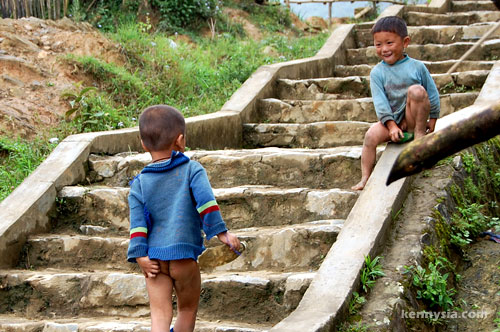
But they’re still happy. Look at the brilliant smiles on their faces.
I was almost convinced to take off my pants and join them.
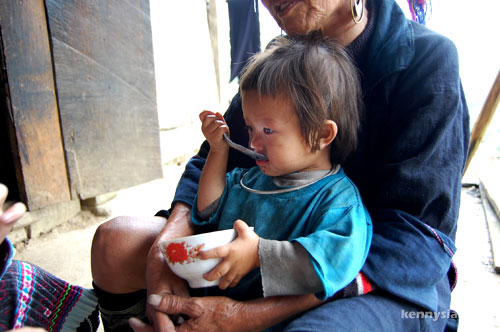
I love it here. Being the countryside, there are no shortage of farm animals and small lifestock around.
A little toddler girl would be eating their lunch. Then next to her will be three puppies sucking frantically on their mom’s titties.
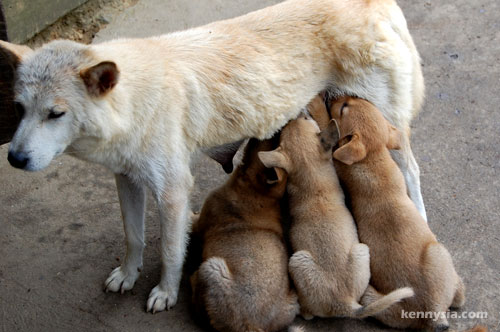
Bitch.
Out of nowhere, a man would be chasing a bunch of mountain goats down the footpath.
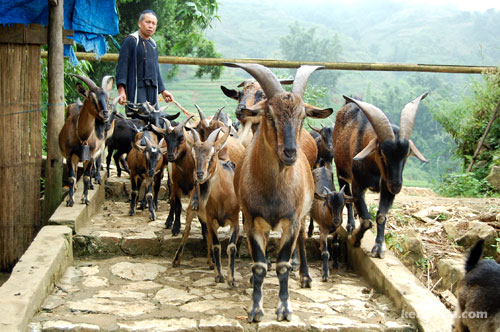
These are the kinda sights you don’t get to see everyday.
Within just a few hours here, we are already relaxed into the slower pace of life here. I’m just glad to be away from all the hectic schedule back home.
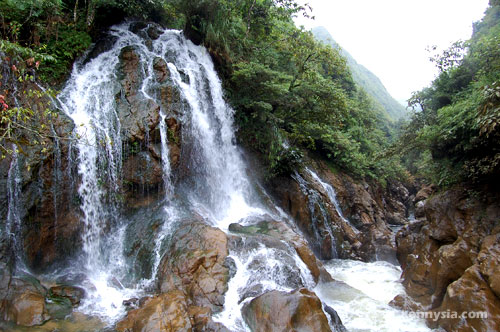
Cat Cat Village isn’t big. We reached the end point of the trek after roughly an hour.
As we still had tons of time to spare, Ha asked if we wanna go to her house in nearby Sin Chai Village where she would cook us some lunch.
Authentic H’mong hospitality? Of course!
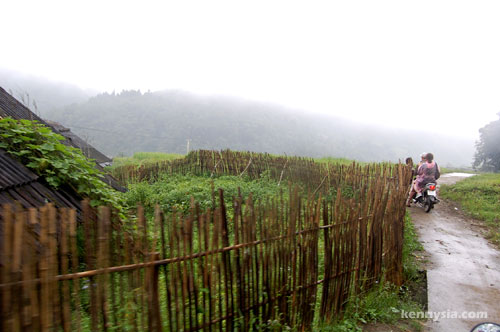
Unfortunately for us, she must have exagerrated the use of the word “near”, because her house ain’t even close to being near.
Sin Chai is located much further away Cat Cat Village and access is only possible with a motorcycle ride (US$1 / RM3.50).
For once, we had gone well and truly off the beaten path, into a place only the locals knew.
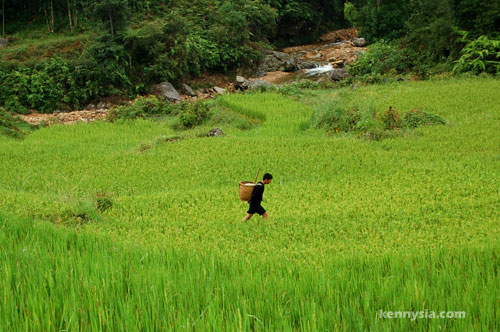
Still, we were glad we came here.
Sin Chai is a lot less touristy and a lot more authenticH’mong village. For the first time in my life, I was inside a true countryside village that is as every bit as I imagined it to be – water buffaloes ploughing through the rice fields, workers harvesting from the terraced hill slopes and a small stream flowing through the valley in between.
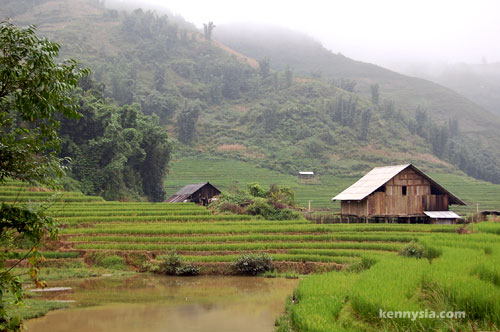
It was surreal.
I felt like I was in one of those water-coloured paintings we used to always do back in secondary school.
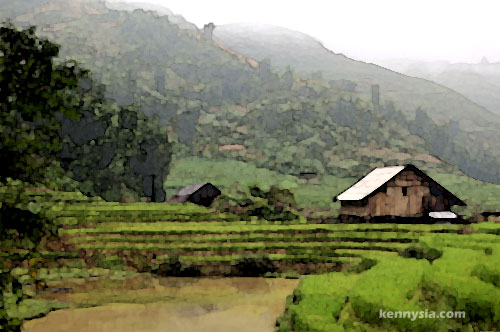
If only I knew how to use Photoshop back then, I wouldn’t be getting a ‘C’ for Arts.
From where the motorcycles dropped us off, we had to trek nearly an hour up and down muddy terrains and slippery rocks.
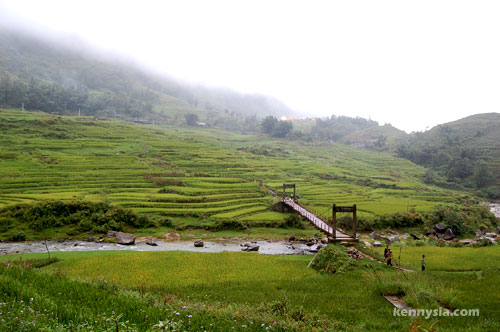
It was difficult navigating up and down the hill, and this is coming from a guy who had climbed Mt Kinabalu before.
Ha was easily hopping from rock to rock like she was previously born a mountain goat. After all, she has been doing this everyday since the day she was born.
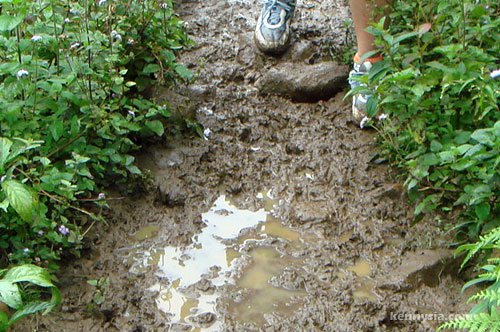
Things didn’t go too well for Nicole. At one point she slipped and hurt her shin.
She was alright, but the little H’mong girl was almost in tears. “I’m sorry!”, she said, guilty that she led us through such a difficult path just to go to her house.
I didn’t know why she had to apologise. I just feel sorry for ourselves that we couldn’t even keep up with a 16-year-old girl half our size!
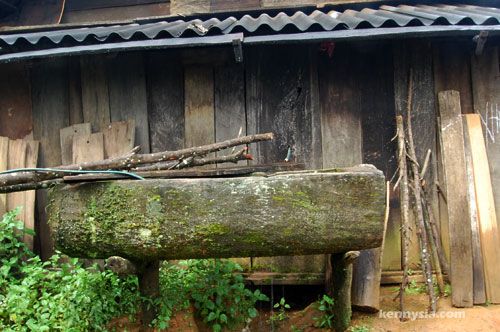
Laundry
Ha’s house was such a welcome relief when we finally reached there.
As simple as it might be, it had all the basic creatures of comfort.
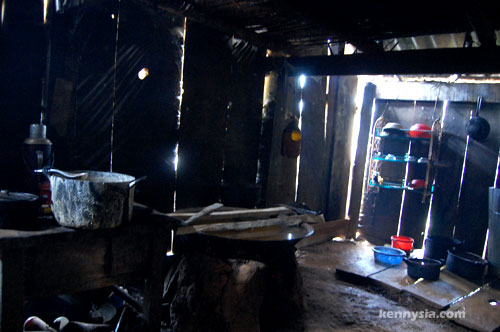
Wash area
Looking around her house, it hit us hard on how poor the H’mong people are. We are on holidays but this was a tough reality check to swallow.
The entire house is only about the size of a standard classroom. The walls are made of wood and the floor is nothing but harderned mud.
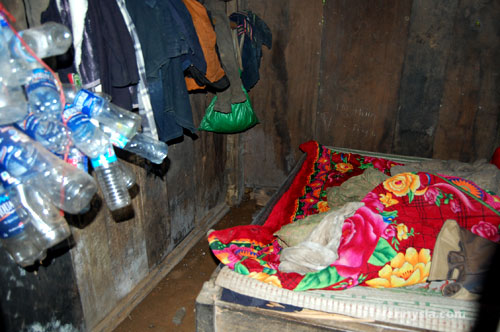
Bedroom
The bedroom has a mattress that has seen better days. There is no wardrobe to store any clothes.
The living area, which is also the dining area, is basically a wooden table with two small benches. There was some corn hanging dry over the roof and some maize piled in the corner. The washing area has a barrel to catch rain water, but no doors. The cooking area is just a stove pit to put the charcoal in.
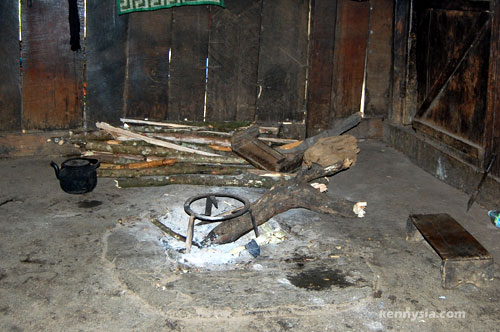
Kitchen
There are no electricity, no toilet, no water pipe, no gas stove, no lights, no carpet, no TV, no couch, no Astro, no computer, no phone, no internet. Pretty much all the things that we took for granted, they don’t have it.
How they managed to live in such conditions, I have no idea.
All they have is roof over their head, and few simple clothes they could wear. There are very few personal belongings, if at all.
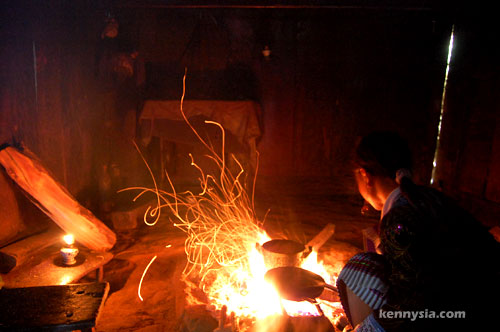
This is no Venetian Macao that’s for sure.
And yet, despite living in extreme poverty, Ha was among the most hospitable person I have ever met. She didn’t have much, but she gave us what she could. I was touched by her generosity.
She washed my dirty sweater in a hollowed log. She invited us into the comforts of her simple home and cooked us lunch. Nothing fancy, just rice and vegie fresh from her backyard. But it was her sincerity that shows.
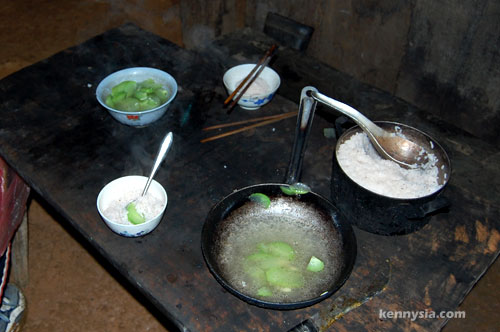
Honestly, one of the best-tasting meals I’ve had in Vietnam. I yearned for her fragrant rice even until today.
Sitting in Ha’s house, part of me feels sad for the H’mong community. Tourism in Sapa may be booming, but little of it directly benefits the ethnic minorities. Many of them still live in extreme poverty and requires Oxfam assistance. Enterprising businessmen had flocked to Sapa to chase tourist money, but the locals didn’t like it.
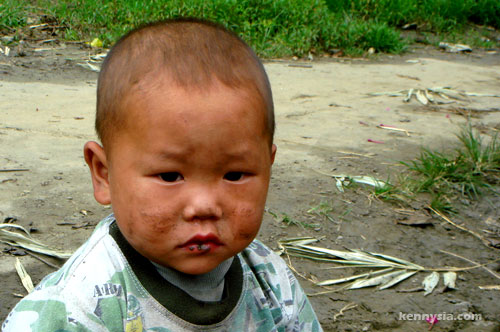
It’s little wonder why the H’mong don’t even regard themselves as Vietnamese. They may be from the same country, but the H’mongs think differently and at least treat their visitors with more dignity than mere cash cows.
Before I left, I bought a traditional handwoven tribal men’s shirt from our little tour guide.
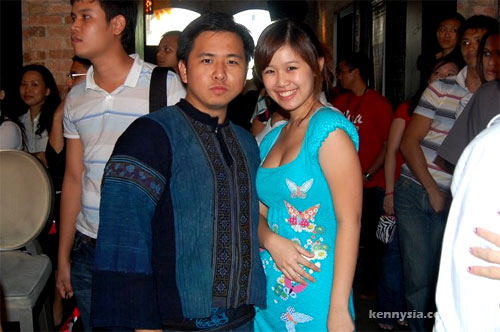
Look at my shirt, don’t look at Su Ann
Ha didn’t name me the price and I didn’t know how much it should cost, but I paid her 150,000 dong (RM30) for it. I knew I paid more than what she expected when her face lit up instantly.
I was happy to. What’s 150,000 dongs compared to her spending the whole day with us, showing us her village, guiding us through the paddy fields, inviting us into her home and cooking a nice lunch for us? When’s the last time a complete stranger did that for me?
It was a token of gratitude from me and I’m sure she’ll put the money to good use back within the H’mong community.
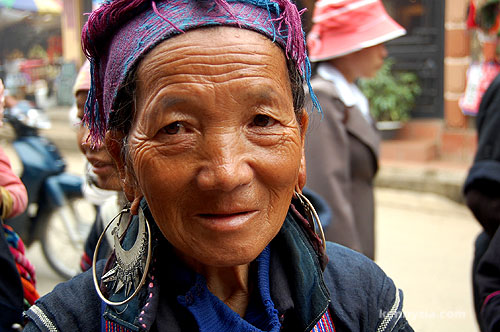
We left Sapa that evening with a warm fuzzy feeling in our stomach. Sapa is a beautiful place and true paradise on Earth, and it is made even more endearing by the presence of the great H’mong tribe.
We were truly humbled by how caring and close-knit they are, and how they managed to remain so happy eventhough they’re so poor.
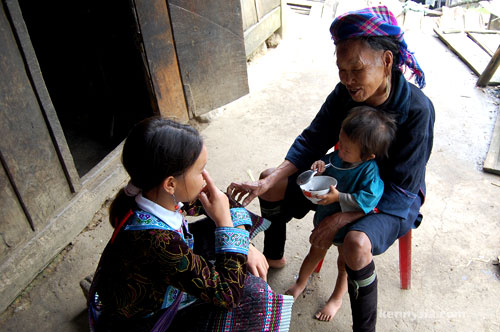
Perhaps, us city folks oughta learn a thing or two from them.